Succulents Care Tips
Also involves many Family and Genus, with their own different care tips.
You can use[Ctrl +F] to find the genus or type you want
Agavaceae: Agave | Apocynaceae:Pachypodium | Asclepiadaceae:Caralluma,Hoya,Huernia,Stapelia | Asteraceae:Senecio | Crassulaceae:Adromischus,Aeonium,Cotyledon,Crassula,Dudleya,Echeveria,Graptopetalum,Kalanchoe,Rostachys,Pachyphytum,Sedum,Sepervivum,Graptoveria | Cucurbitaceae:Gerrardanthus | Didiereaceae:Alluaudia | Dioscoreaceae:Dioscorea | Gesneriaceae:Sinningia | Liliaceae:Haworthia,Bulbine | Aizoaceae:Conophytum,Lithops,Astridia,Dinteranthus Schwantes,Drosanthemum Dicrocaulon | Moraceae:Dorstenia | Portulacaceae:Anacampseros | Cactaceae:Opuntioideae | Other Plants:Tillandsia,Sansevieria,Operculicarya,Haraella,Hyacinthus | Season Type:Summer Type,Winter Type,Spring & Autumn Type
龙舌兰属 Agave
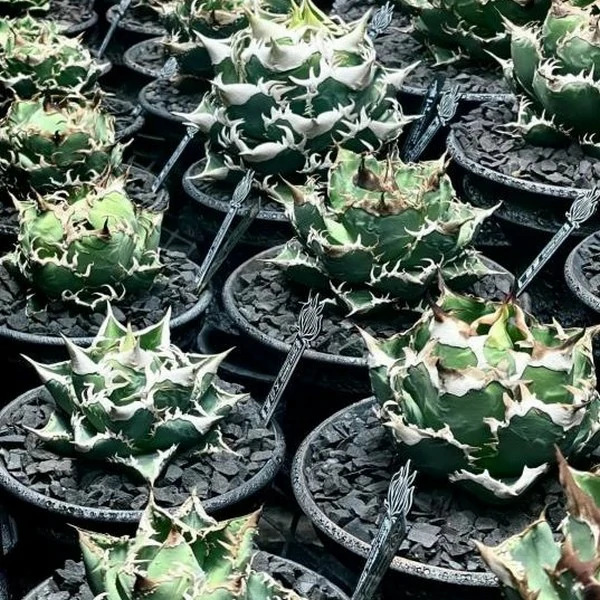
1.土壤:龙舌兰适合生长在疏松、肥沃、排水良好的湿润沙质土壤中。盆栽时,可以将腐叶土、沙壤土混合,并加入少量骨粉作为基肥。
1.Soil: Agave grows best in loose, fertile, well-drained, moist sandy soil. When potting, you can mix Leaf Mould and sandy loam and add a small amount of bone meal as base fertilizer.
2.浇水:龙舌兰耐旱,浇水应遵循“宁干勿湿”的原则。生长季节(春秋两季)可每隔10-15天浇水一次,保持土壤微湿即可;夏季高温时,可以适当增加浇水次数,但要注意避免积水。冬季则需减少浇水频率,甚至可以断水,以防根部腐烂。
2.Watering: Agave is drought-tolerant, so watering should follow the principle of “better dry than wet”. During the growing season (spring and autumn), water once every 10-15 days to keep the soil slightly moist; in the summer when the temperature is high, watering can be increased appropriately, but be careful to avoid water accumulation. In winter, watering frequency should be reduced, or even stopped, to prevent root rot.
3.光照和温度:龙舌兰喜欢充足的阳光,应放置在阳光充足、通风良好的地方。生长适宜的温度为15~25℃,夜间温度保持在10~16℃。冬季低温时,应将龙舌兰移入室内,避免长时间低于5℃的低温。
- Light and temperature: Agave likes plenty of sunlight and should be placed in a sunny and well-ventilated place. The suitable temperature for growth is 15-25℃, and the night temperature should be kept at 10-16℃. In winter, when the temperature is low, the Agave should be moved indoors to avoid long-term low temperatures below 5℃.
4.施肥:龙舌兰对肥料要求不高,但肥沃的土壤有助于其更好的生长。每年可以施肥一次,生长季节每月施一次薄肥,避免频繁施肥导致肥害。
- Fertilization: Agave does not require much fertilizer, but fertile soil helps it grow better. Fertilize once a year and apply liquid fertilizer once a month during the growing season to avoid over-fertilization caused by frequent fertilization.
5.繁殖方法:龙舌兰可以通过分株、扦插或播种的方式进行繁殖。
- Reproduction method: Agave can be propagated by division propagation, cuttings or sowing.
6.病虫害防治:龙舌兰可能会遭受叶斑病、炭疽病、灰霉病以及介壳虫等病虫害的危害,应及时采取措施进行防治。
- Pest and disease control: Agave may be harmed by pests and diseases such as Phoma insidiosa , anthracnose, gray mold and scale insects, and timely measures should be taken to prevent and control them.
7.其他注意事项:龙舌兰在每年的春季换盆,换盆时间为每年的4月份。平时要做好水肥管理,防止浇水过多或施肥过量
- Other precautions: Agave needs to be repotted in spring every year, which is in April. Water and fertilizer management should be done well to prevent overwatering or over fertilization.
8.修剪和移栽:龙舌兰生长迅速,需要及时修剪以保持美观,剪除老叶、病叶和枯叶,并保证修剪部位干燥后再进行移栽。
- Pruning and transplanting: Agave grows rapidly and needs to be pruned in time to maintain its beauty. Remove old, diseased and dead leaves, and ensure that the pruned parts are dry before transplanting.
鹿角海棠属/Astridia spp
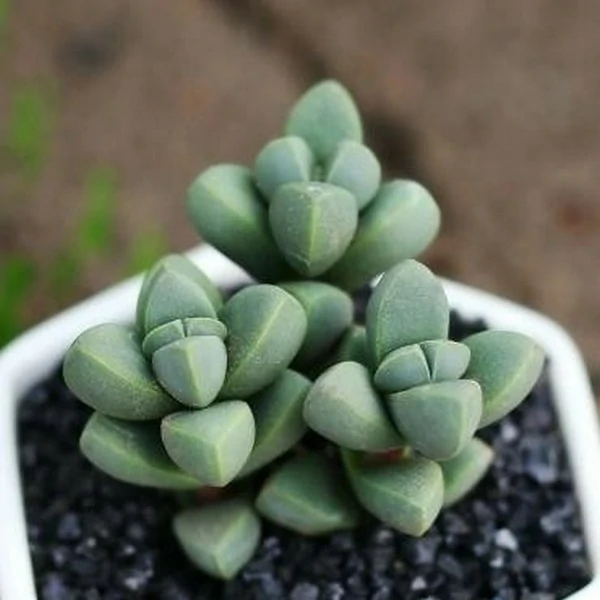
- 土壤选择:鹿角海棠喜欢排水良好、疏松、通气性强的沙壤土。可以使用椰糠、泥炭园土和颗粒土按照1:2:1:1的比例混合配置,或者选择专用的多肉营养土来种植。
- Soil selection: Antler begonia likes sandy loam with good drainage, loose, and strong ventilation. You can use a 1:2:1:1 mixture of coconut husk, peat garden soil and granular soil, or choose a dedicated succulent nutrient soil for planting
2.浇水:鹿角海棠比较耐旱,浇水时要遵循“见干见湿”的原则,即等土壤快要干透了再浇水,且要一次性浇透。夏季高温干燥时要少浇水,最好在傍晚时分进行。
- Watering: Antler begonia is more drought resistant, watering should follow the “see dry see wet” principle, that is, the soil is about to dry out and then watering, and to pour thoroughly at once. Water less when it is hot and dry in summer, preferably in the evening.
3.光照:鹿角海棠需要充足的阳光,每天至少需要接受三四个小时的直射阳光。春季和秋季可以放在室外或阳光充足的室内;夏季和冬季需要放在通风良好、光线明亮的地方,避免直射阳光,以免叶片灼伤 。
- Light: Antler begonia needs plenty of sunlight, at least three to four hours of direct sunlight a day. Spring and fall can be placed outdoors or indoors in full sun; Summer and winter need to be placed in a well-ventilated, bright place to avoid direct sunlight, so as to avoid leaf burns.
4.温度:鹿角海棠适宜的生长温度为15°C-25℃C。冬季要注意保暖,提供至少15℃C左右的温度,以保证其开花;夏季要注意降温,放在通风良好的地方
- Temperature: The appropriate growth temperature for antler begonia is 15°C-25 °C. Winter should pay attention to keep warm, provide a temperature of at least 15℃C or so, to ensure its flowering; In summer, pay attention to cooling and put it in a well-ventilated place.
5.施肥:鹿角海棠对肥料需求不高,生长期每半月施一次薄肥,深秋初冬时以磷钾肥为主,有利于开花和提高抗寒能力。夏季休眠期和冬季低温时要停止施肥
- Fertilization: The demand for fertilizer is not high, the growth period is once every half month to apply thin fertilizer, in late autumn and early winter to phosphate and potassium fertilizer, which is conducive to flowering and improve cold resistance. Fertilization should be stopped during summer dormancy and winter low temperature.
6.繁殖:鹿角海棠可采用扦插繁殖,选取健壮的茎节作为插穗,长度在八至十厘米合适使用沙土作为基质,保持温度在21°℃-25°C之间,大约半个月到二十天可以生根。
- Propagation: Antler begonia can be propagated by cuttings, selecting robust stem segments as cuttings, with a length of eight to ten centimeters and the appropriate use of sandy soil as the substrate, keeping the temperature between 21° C -25°C, about half a month to 20 days to take root.
7.病虫害防治:浇水过多且不通风时,可能会发生根部结线虫病,可以使用3%呋喃丹颗粒剂进行防治。虫害方面,介壳虫危害可以用50%杀松乳油1500倍液喷杀。
- Pest control: root knot nematodes may occur when over-watered and not ventilated, which can be controlled using 3% carbofuran granules. In terms of insect pests, the damage of scale insects can be killed by spraying 1500 times of 50% pine cream.
肉锥花属Conophytum
产大小纳马兰和南非开普省西南部 Conophytum, native to Greater and Lesser Naamaland and southwestern Cape Province, South Africa
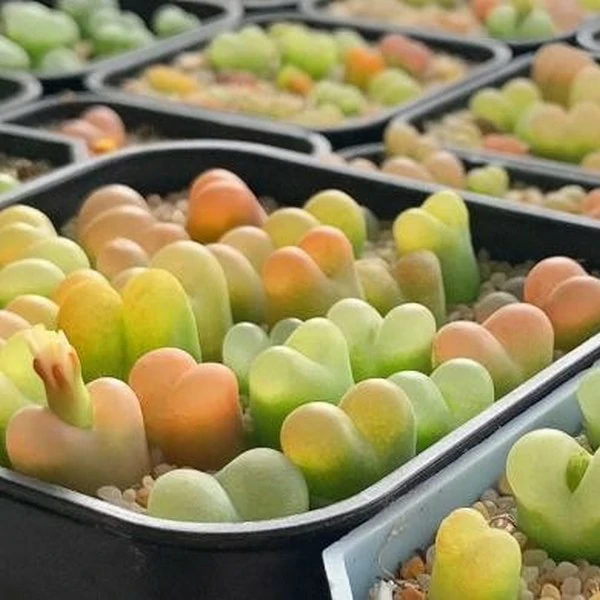
- 土壤选择:肉锥花适宜使用疏松透气的土壤,推荐使用泥炭、珍珠岩和石按照1:1:1的比例配制,或者使用腐叶土、粗砂或蛭石混合物。土壤要保持一定的湿度,但不能有积水,也不能过分干燥 。
- Soil selection: Conophytum is suitable for loose and breathable soil. It is recommended to use peat, perlite and stone in a ratio of 1:1:1, or a mixture of leaf mold, coarse sand or vermiculite. The soil should maintain a certain humidity, but there should be no water accumulation and it should not be too dry.
- 光照管理:肉锥花不能接受阳光直射,过强的光照会导致晒伤,但光照不足也会影响其开花。通常建议让肉锥花隔着玻璃或塑料薄膜接受散射光照射,这样可以保证其正常生长
2.Light managemen: Conophytum cannot accept direct sunlight. Too strong light can cause sunburn, but insufficient light can also affect its flowering. It is usually recommended to let Conus receive scattered light through glass or plastic film to ensure its normal growth.
- 温度控制:肉锥花适直的生长温度最高不能超过20℃,有些品种的温度甚至不要高于15°℃,并且需要有5-10℃C的温差。
3.Temperature control: The maximum growth temperature for Conophytum should not exceed 20°C. The temperature for some varieties should not even be higher than 15°C, and a temperature difference of 5-10°C is required.
- 浇水管理:在生长期时,花盆土变干后一次浇透即可,同时略施薄肥以促进生长。在休眠期时也要适当浇水,但不能浇到花上,要直接浇于土壤。
4.Watering management: During the growing season, water the flowerpot soil thoroughly once it becomes dry, and apply a little fertilizer to promote growth. Water appropriately during the dormant period, but do not water the flowers, but directly water the soil.
- 繁殖方法:肉锥花主要靠分株繁殖,最好选择秋季进行。用剪刀将肉锥花单头带点茎杆直接剪下,或用刀片将群肉锥花带根直接切成几部分。切下的肉锥花一定要将伤口彻底晾干,直到变得干瘪皱缩,然后插入潮湿的土壤中,放在散射光照处发根。
5.Reproduction method: Conophytum mainly rely on division for reproduction, and it is best to choose autumn. Use scissors to directly cut off the stem of a single head of Cone flowers, or use a blade to directly cut a group of Conophytum with roots into several parts. The Conophytum
must be thoroughly dried until they become shriveled and wrinkled, then inserted into moist soil and placed in a diffuse light to root.
肉锥花的生长习性和常见问题:
Conophytum growth habits and common problems:
生长习性:肉锥花适宜凉爽干燥、阳光充足的环境,怕酷热和水涝,耐干旱但不耐赛冷。一般在秋、冬两季开花,花较小,花色众多。
休眠期: 肉锥属于冬种型,夏季休眠,肉锥花的休眠期通常从5月下旬到8月下旬,约3个月时间。休眠期的肉锥花会变成灰白色并开始菱缩 。
Growth habits: Conophytum are suitable for cool, dry, sunny environments, afraid of extreme heat and waterlogging, drought-resistant but not cold-resistant. Generally bloom in autumn and winter, with small flowers and many colors.
Dormant period: Conophytum are winter species and dormant in summer. The dormant period of Conophytum is usually from late May to late August, about 3 months. Conophytum in dormancy will turn gray and begin to shrink.
春桃玉属 Dinteranthus Schwantes
分布于南非北开普省干燥的西北部及纳米比亚的东南部Dinteranthus Schwantes is found in the dry northwest of South Africa’s Northern Cape province and southeastern Namibia.
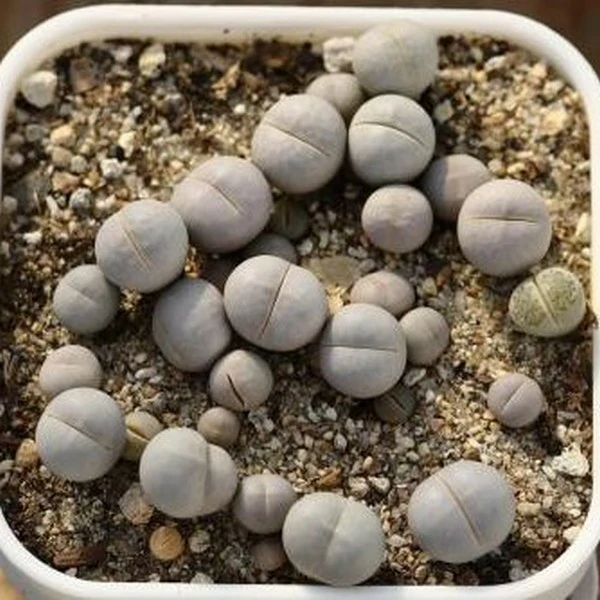
是典型的冬型种,害怕高温高湿的环境,深秋到早春是生长旺季。
It is a typical winter species, afraid of high temperature and high humidity environment. Late autumn to early spring is the peak growing season.
- 土壤选择:春桃玉属多肉植物适直使用疏松、透气、排水良好的土壤。可以使用泥炭士、珍珠岩、蛭石等混合配制,确保土壤的排水性和透气性。
- Soil selection: Loose, breathable, and well-drained soil is suitable for succulent plants of the genus Peach Jasmine. You can use a mixture of peat, perlite, vermiculite, etc. to ensure the drainage and air permeability of the soil.
2.光照管理:大多数多肉植物需要充足的光照,但春桃玉属多肉植物在夏季高温时要适当遮荫,避免强光灼伤。适宜的温度一般在10-25℃左右,冬季注意防赛,夏季注意防暑降温。
2.Light management: Most succulents need sufficient light, but the genus Peach Jade succulents need to be properly shaded during the high temperature in summer to avoid strong light burns. The suitable temperature is generally around 10-25℃. Pay attention to preventing frostbite in winter and preventing heatstroke in summer.
3.浇水频率:遵循“不干不浇,浇则浇透”的原则,避免积水导致烂根。根据季节和环境适当调整浇水频率,避免高温高湿的环境。
3.Watering frequency: follow the principle of “don’t water unless the soil is dry, and water thoroughly when you do”, to avoid water accumulation and root rot. Adjust the watering frequency appropriately according to the season and environment, and avoid high temperature and high humidity environments.
4.温度控制:春桃玉属多肉植物适直在10-25℃的温度范围内生长,冬季要注意防寒,夏季要注意防暑降温。
4.Temperature control: Spring peach jade succulent plants grow best in the temperature range of 10-25℃. Pay attention to cold protection in winter and heat prevention and cooling in summer.
5.繁殖方法:春桃玉属多肉的种子极其细小,出苗率较低,生长缓慢。播种时需要使用足够多的细泥炭,并保持较高的空气湿度。播种后要严格消毒土壤,避免菌发。
5.Reproduction method: The seeds of the genus Peach Jade are extremely small, with a low germination rate and slow growth. When sowing, you need to use enough fine peat and maintain a high air humidity. After sowing, the soil must be strictly disinfected to avoid fungus.
6.病虫害防治:保持良好的通风环境,定期检查植物,发现病虫害及时处理,可以使用相应的药剂进行防治。
6.Pest and disease control: Maintain a well-ventilated environment, check plants regularly, and deal with pests and diseases in a timely manner if found. You can use appropriate pesticides for prevention and control.
银杯玉属/Drosanthemum Dicrocaulon
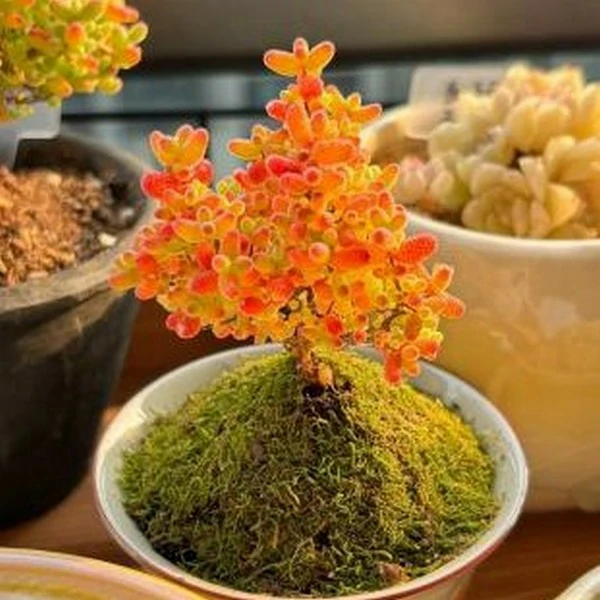
1光照
银杯玉属多肉植物喜欢阳光充足的环境,但在夏季高温时需要适当遮阳,避免强光灼伤叶片。春秋两季可以给予充足的光照,冬季则需注意保暖,避免温度过低导致叶片冻伤
1 Light
Drosanthemum Dicrocaulon prefers an environment with plenty of sunlight, but requires appropriate shading during the high temperatures of summer to prevent the leaves from being scorched by intense light. In the spring and autumn seasons, it can be given ample sunlight, while in winter it is important to keep it warm to prevent the leaves from being frostbitten due to low temperatures.
2土壤
适宜的土壤对于银杯玉属多肉植物的生长至关重要。它们喜欢疏松、透气、排水良好的土壤。前期可以使用泥炭土和珍珠岩的混合土,后期可以增加颗粒土的比例,以提供更好的排水性。避免使用过于粘重的土壤,以免导致根部腐烂。
2 Soil
Suitable soil is essential for the growth of Drosanthemum Dicrocaulon. They prefer loose, breathable, well-drained soil. A mixture of peat soil and perlite can be used in the early stage, and the proportion of granular soil can be increased in the later stage to provide better drainage. Avoid using soil that is too heavy and sticky to cause root rot.
3浇水
银杯玉属多肉植物的浇水原则是“干透浇透”,避免积水。当外侧叶子变软且颜色因缺水发灰时再浇水。夏季高温时需减少浇水频率,避免盆内积水。春秋季节可以见干见湿地浇水,保持土壤微湿。
3 Watering
The watering principle of Drosanthemum Dicrocaulon is “dry thoroughly then pour thoroughly” to avoid water accumulation. Water when the outer leaves are soft and gray from lack of water. The frequency of watering should be reduced in summer when the temperature is high to avoid water accumulation in the basin. Spring and autumn season should keep the soil slightly wet.
4温度
适宜的生长温度为10-30℃之间。夏季高温时,银杯玉属多肉植物会短暂休眠,需要适当遮阳和减少浇水。冬季温度不宜低于5℃,以防叶片冻伤。冬季需注意保温,避免低温环境
4 Temperature
The optimum growth temperature is between 10-30℃. During high summer temperatures, the succulents are dormant for a short time, requiring proper shading and reduced watering. Winter temperature should not be lower than 5℃to prevent frost damage of the leaves. It is important to keep the plant warm in winter to avoid low-temperature environments.
生石花属Lithops
广泛分布于南非和纳米比亚东南部Lithops, Widely distributed in South Africa and southeastern Namibia
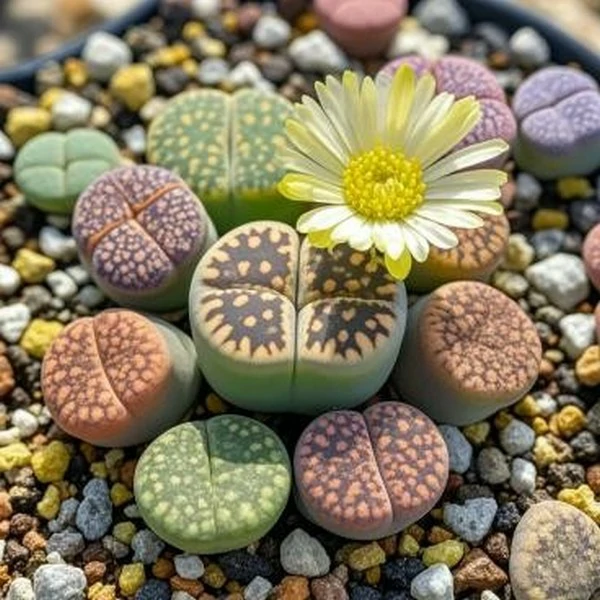
- 温度管理:生石花适宜的生长温度为15至25摄氏度,避免高温和低温环境。在夏季高温时,应采取措施降温并增加通风,以防病害发生。冬季温度应保持在10摄氏度以上,避免赛冷和霜冻,气温降至7摄氏度以下时,生石花会进入休眠状态,此时应加强保温措施 。Temperature management: The suitable growth temperature of Lithops is 15 to 25 degrees Celsius, avoiding high and low temperature environments. In the summer when the temperature is high, measures should be taken to cool down and increase ventilation to prevent diseases. The temperature in winter should be kept above 10 degrees Celsius to avoid cold and frost. When the temperature drops below 7 degrees Celsius, Lithops will enter a dormant state, and insulation measures should be strengthened at this time.
- 适量浇水:生石花在生长季节(春秋季)需要适度浇水,但要避免过度湿润,以免生青苔。夏季和冬季应减少浇水频率,甚至完全断水。浇水时间一般在晚上或清晨温度较低的时候进行,避免在白天温度较高时浇水 。
- Watering in moderation: Lithops need moderate watering during the growing season (spring and autumn), but avoid excessive moisture to prevent moss growth. Watering frequency should be reduced in summer and winter, or even completely cut off. Watering is generally done at night or in the early morning when the temperature is lower, and avoid watering when the temperature is higher during the day.
3.充足光照:生石花喜欢充足的阳光,尤其在春、秋、冬三季应尽量提供充足的光照。夏季应适当遮阴,避免直接暴晒,以保持叶色鲜艳。
- Adequate light: Lithops likes sufficient sunlight, especially in spring, autumn and winter. In summer, it should be properly shaded to avoid direct exposure to keep the leaves bright.
4.适时施肥:生石花在生长季节需要适量施肥,建议每半个月施一次稀薄的液体肥料,但要避免肥料直接接触到球状叶片。开花后应立即停止施肥。
- Timely fertilization: Lithops need to be fertilized in moderation during the growing season. It is recommended to apply thin liquid fertilizer once every half a month, but avoid direct contact of the fertilizer with the spherical leaves. Fertilization should be stopped immediately after flowering.
5.蜕皮期护理:生石花在蜕皮期应停止浇水,让植株从老叶中吸收养分,加速蜕皮过程同时增加光照,停止施肥,并避免用手撕扯外皮
- Molting period care: Lithops should stop watering during the molting period, allowing the plant to absorb nutrients from the old leaves, accelerate the molting process while increasing light, stop fertilizing, and avoid tearing the outer skin with your hands
6.土壤选择:使用排水良好的土壤,通常由粗砂、珍珠岩、赤玉土等混合而成。良好的排水对于避免根部腐烂至关重要 。
- Soil selection: Use well-drained soil, usually a mixture of coarse sand, perlite, Akadama, etc. Good drainage is essential to avoid root rot.
7.繁殖方法:生石花可以通过分株或播种的方式繁殖。分株通常在春季进行,而播种则需要在适宜的温度和湿度条件下进行
- Reproduction method: Lithops can be propagated by division or sowing. Division is usually carried out in spring, while sowing needs to be carried out under suitable temperature and humidity conditions
棒槌树属 Pachypodium
布于安哥拉、纳米比亚和马达加斯加 Pachypodium, found in Angola, Namibia and Madagascar
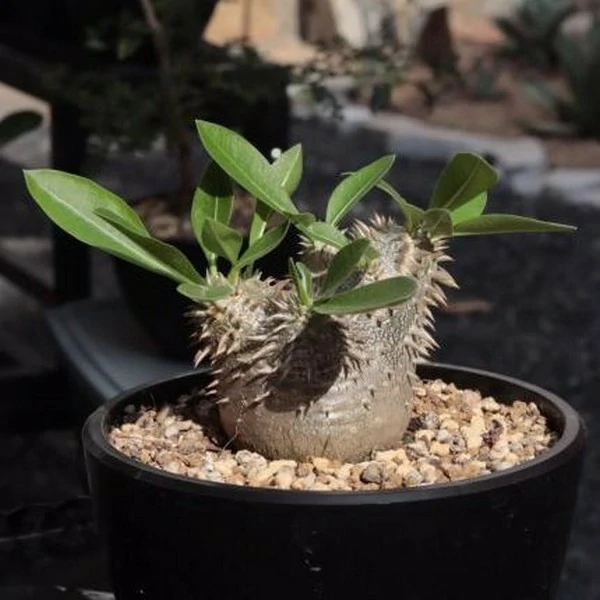
- 光照:棒槌树属多肉植物喜欢充足的阳光,但应避免暴晒。适直的生长温度为20-30℃冬季需注意保暖。
- Light: Like full sunlight, but should avoid exposure. The suitable growth temperature is 20-30 ℃, and it is necessary to keep warm in winter.
- 温度:不耐寒,冬季温度不能低于15℃,否则叶片会枯黄脱落,进入休眠状态。若温度低于5℃,则会出现冻害。温度过高也会导致落叶休眠。冬季若温度保持在20℃左右可继续生长,若无法保持较高温度,应减少以至停止浇水,令其自然休眠。
2.Temperature: it is not cold-resistant, the winter temperature can not be lower than 15℃, otherwise the leaves will wither and fall off and enter a dormant state. If the temperature is below 5℃, freezing damage will occur. Excessive temperatures can also cause fallen leaves to become dormant. In winter, if the temperature is maintained at about 20℃, it can continue to grow, if it cannot maintain a higher temperature, it should be reduced or even stopped watering, so that it can be naturally dormant.
- 浇水:保持土壤湿润,但不要积水。
3.Water: Keep the soil moist, but not stagnant.
- 施肥:在生长季节每月施一次稀薄的液肥。
4.Fertilization: Thin liquid fertilizer is applied once a month during the growing season.
- 土壤:适宜的土壤应为疏松、肥沃且排水良好的砂质壤土,最好用腐叶土、珍珠岩、粗沙配制栽培基质。
5.Soil: The suitable soil should be loose, fertile and well-drained sandy loam, preferably with leaf soil, perlite, coarse sand preparation of cultivation medium.
注意事项: Note:
棒槌树属多肉植物的汁液有毒,养护过程中要避免接触到皮肤和眼睛。
Their sap is toxic, and contact with skin and eyes should be avoided during curing process.
萝摩科/Asclepiadaceae
分布于东半球热带地区Asclepiadaceae, distributed in the tropical regions of the Eastern Hemisphere
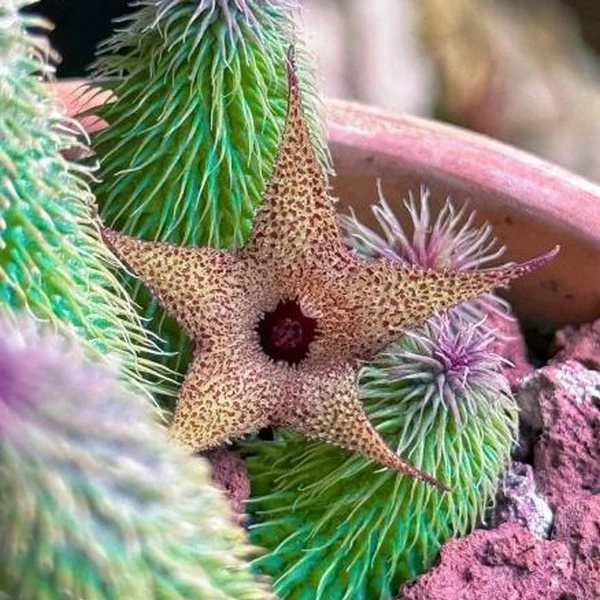
- 光照:萝摩科多肉植物大多喜欢阳光充足的环境,但也要注意避免强光直射,尤其是在夏季高温时需要适当遮阴,以防止植物被晒伤。
- Light: Most succulents from the Asclepiadaceae family prefer environments with plenty of sunlight, but it is also important to avoid direct exposure to harsh light, especially during the high temperatures of summer when some shading is necessary to prevent the plants from being sunburned.
2.温度:这些植物大多不耐寒,冬季温度不应低于5℃℃,夏季高温时也要注意通风降温,避免高温对植物造成不利影响。
- Temperature: These plants are mostly not cold-tolerant, and the temperature in winter should not drop below 5°C. During the high temperatures of summer, it is also important to ensure ventilation and cooling to prevent adverse effects on the plants from the heat.
3.浇水:萝摩科多肉植物大多耐干旱,浇水不直过多,特别是在夏季和冬季休眠期要减少浇水频率,保持土壤稍干燥为宜。
- Watering: Succulents from the Asclepiadaceae family are mostly drought-resistant, so watering should not be excessive. Especially during the dormant periods of summer and winter, the frequency of watering should be reduced to keep the soil slightly dry.
4.土壤:适直使用肥沃、排水良好的沙壤土,避免使用黏重的土壤,以免造成根部腐烂。
- Soil: It is suitable to use fertile, well-draining sandy loam soil, avoiding heavy clay soils to prevent root rot.
- 繁殖方法:萝摩科多肉植物可以通过分株和扦插的方式进行繁殖。分株在春季进行,扦插则选择充实、短而粗的茎干作为插穗,插后需保持适宜的湿度和温度。
Propagation Methods: Succulents from the Asclepiadaceae family can be propagated through division and cuttings. Division is best done in spring, while cuttings should use plump, short, and thick stems as cuttings, and after planting, it is necessary to maintain appropriate humidity and temperature.
6.病虫害防治:常见的病虫害有黑斑病、茎腐病和粉虱等,可以使用相应的药剂进行防治。
- Pest and Disease Prevention: Common pests and diseases include black spot, stem rot, and whiteflies. Appropriate pesticides can be used for control.
水牛掌属 Caralluma
产北非、东非和阿拉伯地区Caralluma, native to North Africa, East Africa and Arabia
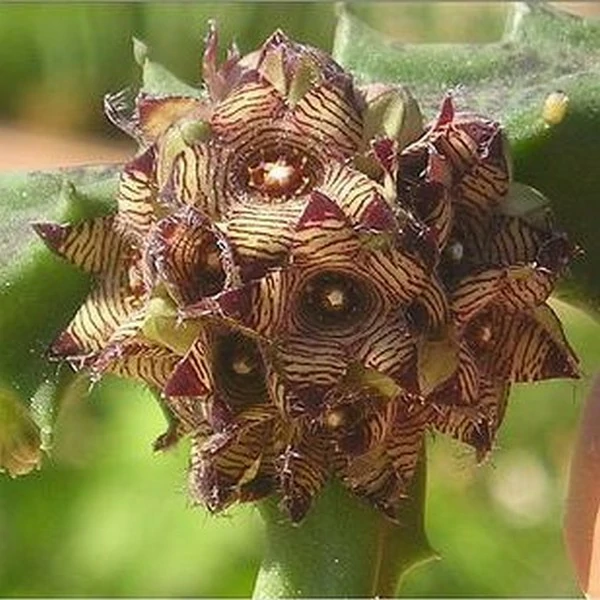
水牛掌属多肉植物的养护要点主要包括以下几点:
The main points of caring for Caralluma succulents include the following:
- 光照:水牛掌属多肉植物需要充足的阳光,最好每天能够接受至少6小时的直射阳光。如果光照不足,植物的生长会受到影响,叶片颜色和形态也会发生变化。
- Light: Caralluma succulents need sufficient sunlight, preferably at least 6 hours of direct sunlight per day. If there is insufficient light, the growth of the plant will be affected, and the color and shape of the leaves will also change.
- 温度:适宜的生长温度为20-30摄氏度,冬季温度不低于10摄氏度。夏季高温时需要注意遮荫,避免强烈阳光直射。
2.Temperature: The suitable growth temperature is 20-30 degrees Celsius, and the winter temperature is not lower than 10 degrees Celsius. When the temperature is high in summer, you need to pay attention to shade and avoid strong direct sunlight.
- 浇水:浇水要适量,避免积水。生长季节(春季和秋季)可以每2-3周浇一次水,夏季和冬季则需减少浇水频率,保持土壤微湿即可。
- Watering: Water in moderation to avoid water accumulation. During the growing season (spring and autumn), you can water once every 2-3 weeks. In summer and winter, you need to reduce the watering frequency and keep the soil slightly moist.
- 施肥:生长季节可以每月施一次稀薄的液肥,但要注意不要过量,避免烧根。
- Fertilization: During the growing season, you can use a thin liquid fertilizer once a month, but be careful not to overdo it to avoid burning the roots.
- 土壤:使用排水良好的沙质土壤或珍珠岩、蛭石和泥炭土的混合土壤,以确保良好的排水性。
5.Soil: Use well-drained sandy soil or a soil mix of perlite, vermiculite and peat to ensure good drainage.
球兰属 Hoya
产亚洲和大洋洲Hoya, native to Asia and Oceania
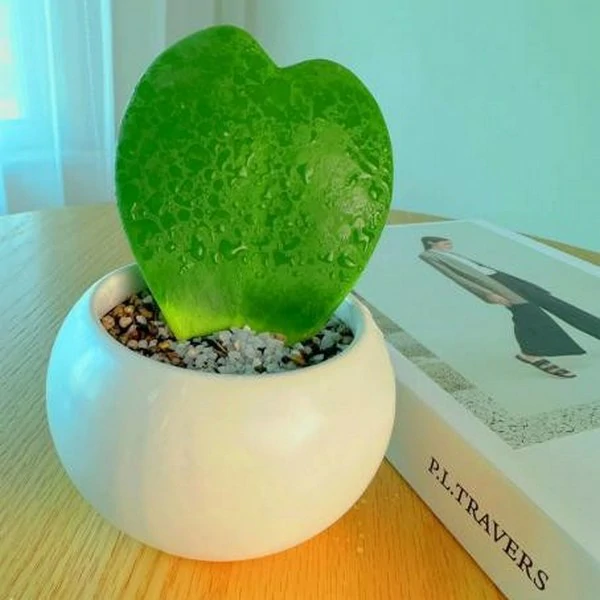
水牛掌属多肉植物的养护要点主要包括以下几点:
The main points of caring for Caralluma succulents include the following:
- 光照:水牛掌属多肉植物需要充足的阳光,最好每天能够接受至少6小时的直射阳光。如果光照不足,植物的生长会受到影响,叶片颜色和形态也会发生变化。
- Light: Caralluma succulents need sufficient sunlight, preferably at least 6 hours of direct sunlight per day. If there is insufficient light, the growth of the plant will be affected, and the color and shape of the leaves will also change.
- 温度:适宜的生长温度为20-30摄氏度,冬季温度不低于10摄氏度。夏季高温时需要注意遮荫,避免强烈阳光直射。
2.Temperature: The suitable growth temperature is 20-30 degrees Celsius, and the winter temperature is not lower than 10 degrees Celsius. When the temperature is high in summer, you need to pay attention to shade and avoid strong direct sunlight.
- 浇水:浇水要适量,避免积水。生长季节(春季和秋季)可以每2-3周浇一次水,夏季和冬季则需减少浇水频率,保持土壤微湿即可。
- Watering: Water in moderation to avoid water accumulation. During the growing season (spring and autumn), you can water once every 2-3 weeks. In summer and winter, you need to reduce the watering frequency and keep the soil slightly moist.
- 施肥:生长季节可以每月施一次稀薄的液肥,但要注意不要过量,避免烧根。
- Fertilization: During the growing season, you can use a thin liquid fertilizer once a month, but be careful not to overdo it to avoid burning the roots.
- 土壤:使用排水良好的沙质土壤或珍珠岩、蛭石和泥炭土的混合土壤,以确保良好的排水性。
5.Soil: Use well-drained sandy soil or a soil mix of perlite, vermiculite and peat to ensure good drainage.
剑龙角属Huernia
产东非、南非和阿拉伯地区,代表种有剑龙角、赤鬼角等Originated from East Africa, South Africa and Arabia, representative species include Huernia, Huernia zebrina
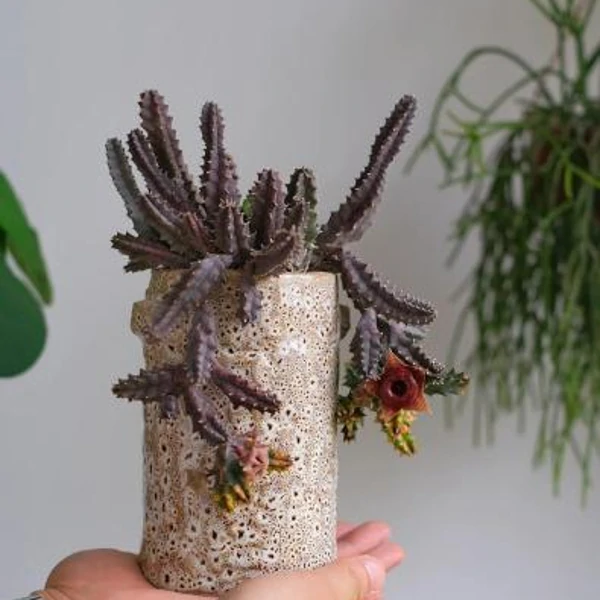
剑龙角属多肉的养护需要注意以下几点:
The following points should be noted in the maintenance of Huernia:
- 光照与温度:剑龙角属多肉喜欢光照充足的环境,但应避免烈日曝晒。适宜的生长温度为20~30℃。在冬季,应将剑龙角放置在室内,保持温度在6℃以上以帮助其越冬。
- Light and temperature: Huerniaprefers an environment with sufficient light, but should avoid exposure to the sun. The suitable growth temperature is 20~30℃. In winter, the Huernia should be placed indoors and the temperature should be kept above 6℃ to help it overwinter.
2.水分管理:剑龙角属多肉喜欢干燥环境,盆土应保持干燥,避免积水。在秋季温度下降后至早春期间,应减少浇水,以避免根系积水导致烂根。
- Water management: Huernia prefers a dry environment, and the potting soil should be kept dry to avoid water accumulation. After the temperature drops in autumn to early spring, watering should be reduced to avoid water accumulation in the root system and root rot.
3.土壤选择:剑龙角属多肉喜欢疏松、排水良好的砂质壤土。配土时可以不放颗粒,但一定要保证土壤疏松透气。如果没有河沙,可以使用珍珠岩代替,但要注意珍珠岩过多可能导致土壤透气性太好,容易导致植株缺水。
- Soil selection: Huernia prefers loose, well-drained sandy loam. When mixing the soil, you can omit the particles, but make sure that the soil is loose and breathable. If there is no river sand, perlite can be used instead, but be aware that too much perlite may cause the soil to be too breathable, which may easily lead to water shortage in the plant.
4.施肥:剑龙角属多肉从春天开始可以施肥,可以使用缓释肥或有机复合肥。花前可以每隔半个月左右施一次以磷钾肥为主的液体肥料。
- Fertilization: Huernia can be fertilized from spring, and slow-release fertilizers or organic compound fertilizers can be used. Before flowering, liquid fertilizer mainly composed of phosphorus and potassium fertilizer can be applied every half a month or so.
5.繁殖方法:剑龙角属多肉没有叶片,因此不能通过叶插繁殖。繁殖方法包括分株或播种,但剑龙角属多肉从播种到开花一般需要较长时间。
- Propagation method: Huernia succulents have no leaves, so they cannot be propagated by leaf cuttings. Propagation methods include division or sowing, but it usually takes a long time for Huernia succulents to bloom from sowing.
常见问题及解决方法:
Common problems and solutions:
病虫害防治:常见的病虫害有介壳虫和根粉蚧。在配土时可以在土壤中放入一些小白药,并注意通风,以预防病虫害的发生。
Pest and disease control: Common pests and diseases include scale insects and root mealybugs. When preparing the soil, you can put some small white medicine in the soil and pay attention to ventilation to prevent the occurrence of pests and diseases.
冬季养护:冬季应注意保持温度在6℃以上,最好拿到室内养殖,避免低温导致冻害”
Winter maintenance: In winter, you should pay attention to keeping the temperature above 6°C. It is best to bring it indoors to avoid freezing damage caused by low temperatures.
国章属/豹皮花属Stapelia
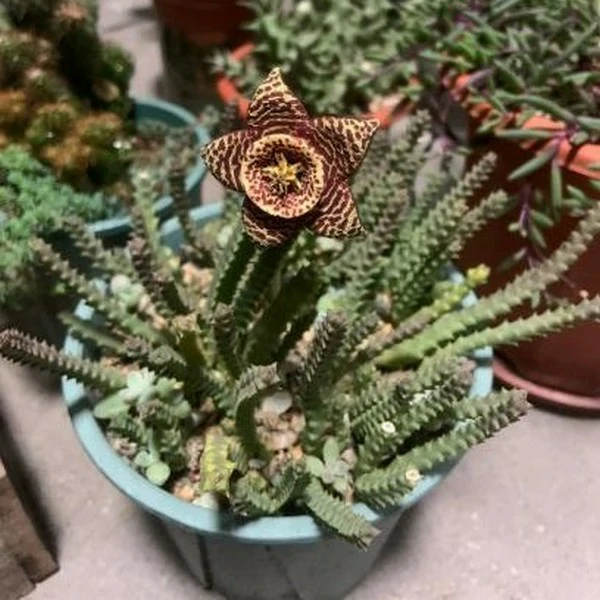
- 土壤选择:豹皮花属多肉植物喜欢疏松、排水良好的土壤。可以在普通土壤中加入粗沙或沙土,或者在泥炭土中添加珍珠岩,保持土壤的透气性和排水性。
- Soil selection : Succulents like loose, well-drained soil. Coarse sand or sandy soil can be added to ordinary soil, or perlite can be added to peat soil to maintain soil permeability and drainage.
2.温度控制:豹皮花属多肉植物适宜的生长温度在18~28度之间。冬季最低温度应保持在4度以上,以避免冻伤。在冬季,需要将植物移至室内或阳光充足的窗台进行保暖。
2. Temperature control : The suitable growth temperature of the succulent leopard skin is between 18 and 28 degrees. The minimum temperature in winter should be kept above 4 degrees to avoid frostbite. In winter, plants need to be moved indoors or to a sunny windowsill to keep warm.
3.光照需求:豹皮花属多肉植物需要充足的光照,适合养在阳光较多的地方。如果光照不足,植物的生长会受到影响,甚至不开花。
3. Light requirement : The succulent leopard skin needs plenty of light and is suitable for keeping in sunny places. If the light is not enough, the growth of the plant will be affected, and even do not flower.
4.浇水管理:豹皮花属多肉植物比较耐干旱,避免浇水过量导致积水。通常在土壤干透后再进行浇水,如果光照不足,可以让土壤稍微干燥后再浇水。
4. Watering management : The succulent leopard skin is relatively tolerant to drought and avoids excessive watering which causes stagnant water. Usually water the soil after it is dry, if the light is insufficient, you can let the soil dry slightly before watering.
5.施肥方法:在生长期,每隔2-3周施一次液肥。夏季和秋季无需施肥,只需更换2-3次培养土即可。
5. Fertilization method : In the growing period, apply liquid fertilizer every 2-3 weeks. No fertilization is required in summer and autumn, and only 2-3 changes of culture soil are required.
6.毒性处理:豹皮花属多肉植物具有一定的毒性,栽培时应避免嘴巴和皮肤接触植物汁液。
6. Toxic treatment : leopard skin is a succulent plant with certain toxicity, cultivation should avoid mouth and skin contact with plant juice.
千里光属 Senecio
大多数种类夏季休眠Senecio,most of them hibernate during summer.
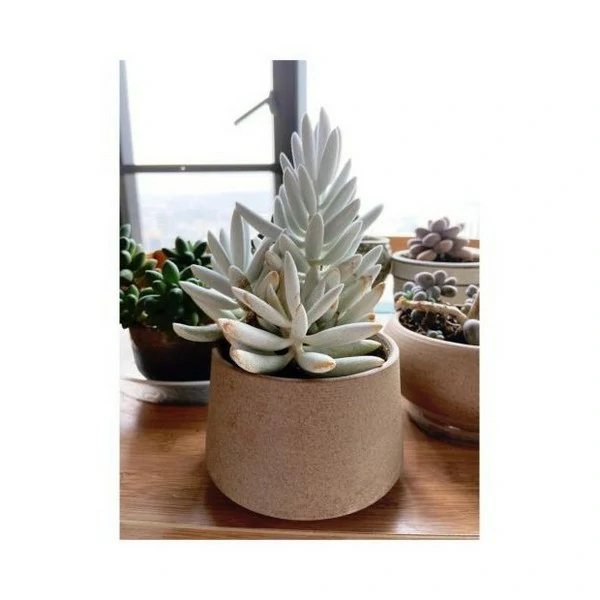
- 光照:千里光属多肉植物需要充足的光照,但夏季要避免午后强烈的阳光直射,以免晒伤。室内种植时,应放在明亮的地方,避免长时间处于阴暗处,否则植物会变得瘦长。
1.Light: Senecio succulents need plenty of light, but avoid strong direct sunlight in the afternoon in summer to avoid sunburn. When planted indoors, they should be placed in a bright place and avoid being in the shade for a long time, otherwise the plants will become thin and long.
2.土壤:这些植物喜欢排水良好的土壤,因此必须使用底部至少有一个排水孔的花盆。可以在土壤中添加2~3等份的河沙或珍珠岩,以保持良好的透气性和排水性。
2.Soil: These plants prefer well-drained soil, so you must use a pot with at least one drainage hole at the bottom. You can add 2 to 3 equal parts of river sand or perlite to the soil to maintain good aeration and drainage.
3.温度:千里光属多肉植物耐寒性较低,最低可达-6.7°℃,但低于冰点时无法存活。冬季最低养护温度应保持在5°C以上。
3.Temperature: Senecio succulents have low cold tolerance, the lowest temperature can reach -6.7℃, but they cannot survive below freezing. The minimum maintenance temperature in winter should be kept above 5℃.
4.浇水:千里光属多肉植物耐旱,但土壤不应长时间干燥。在生长季节需要适量浇水,避免土壤长时间湿润。冬季要减少浇水频率。
4.Watering: Senecio succulents are drought-tolerant, but the soil should not be dry for a long time. Water appropriately during the growing season to avoid long-term wet soil. Reduce the frequency of watering in winter.
5.施肥:每年夏季可以给植物施一次肥,使用平衡的水溶性肥料的稀溶液。
5.Fertilization: The plants can be fertilized once a year in summer, using a dilute solution of a balanced, water-soluble fertilizer.
6.繁殖:千里光属多肉植物可以通过种子或扦插繁殖。种子需要温暖的温度和恒定的湿度来发芽,扦插则在春季和夏季进行,插入排水良好的土壤中,保持温暖和充足的阳光。
6.Propagation: Senecio can be propagated by seeds or cuttings. Seeds require warm temperatures and consistent humidity to germinate, while cuttings are taken in spring and summer, inserted into well-drained soil, kept warm and in full sun.
7.病虫害防治:千里光属多肉植物可能受到粉虱的影响,需要注意防治 。
7.Pest and disease control: Senecio succulents may be affected by whiteflies and need to be controlled.
8.毒性:部分千里光属多肉植物有毒,如果有孩子或宠物,需小心种植,避免误食。
8.Toxicity: Some Senecio succulents are poisonous. If you have children or pets, you need to be careful when planting them to avoid accidental ingestion.
仙人掌亚科Opuntioideae
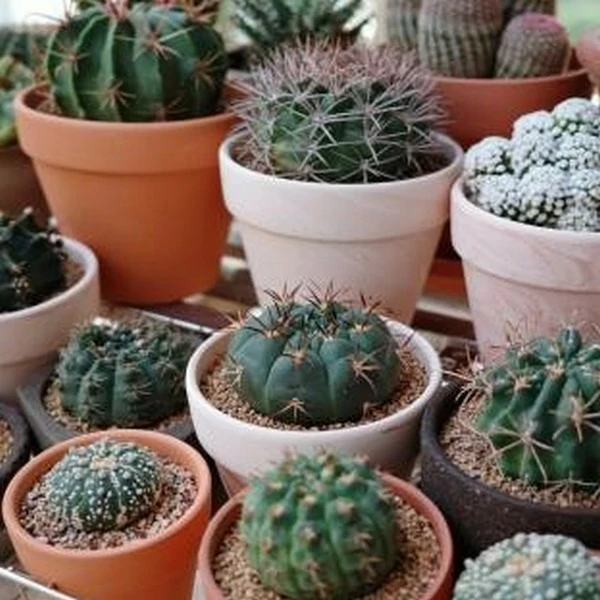
- 选择合适的土壤:仙人掌喜欢砂质土壤,因此选择透气性好、含沙量高的土壤较为适宜。一般建议使用蛭石、珍珠岩、河沙等松散的介质作为培养土,可以增强土壤的透水性和透气性。
- Choose the right soil: cactus like sandy soil, so choose a good permeability, high sand content of the soil is more suitable. It is generally recommended to use vermiculite, perlite, river sand and other loose media as culture soil, which can enhance the water permeability and air permeability of the soil.
- 控制浇水量:仙人掌是干旱植物,因此浇水要适度。在生长期,每次浇水前要等到土壤完全干燥,再进行浇水,以免引起根部腐烂。在冬季休眠期,减少浇水量,保持土壤略湿即可。
2.Control watering: Cactus are arid plants, so water them in moderation. During the growing season, wait until the soil is completely dry before watering each time, so as not to cause root rot. During the winter dormant period, reduce the amount of watering and keep the soil slightly wet.
3.合理施肥:仙人掌的营养需求较低,不需要经常施肥。在生长期,可以每月或每两个月给仙人掌施一次稀释后的多肉植物肥料。注意不要过量施肥,以免损害仙人掌的生长。
3.Reasonable fertilization: Cactus has low nutritional requirements and does not require frequent fertilization. During the growing season, the cactus can be given a diluted succulent fertilizer once a month or once every two months. Be careful not to over-fertilize, so as not to damage the growth of cactus.
4.提供充足的阳光:仙人掌喜欢明亮的阳光,因此需要选择充足的光照位置。室内养殖的仙人掌可以选择朝南或朝西的窗户,尽量让它们能够得到全天的阳光照射。在夏季高温时,需要避免强烈的直射阳光,可以使用遮阳网等方式进行遮挡。
4.Provide plenty of sunlight: Cacti like bright sunlight, so you need to choose plenty of light locations. Indoor cactus can choose to face south or west of the window, so that they can get as much sunlight as possible throughout the day. In the summer high temperature, you need to avoid strong direct sunlight, you can use sunshade nets and other ways to block.
5.适宜的温度和湿度:仙人掌适应较宽的温度范围,一般在15℃-30℃之间生长最佳。在冬季休眠期,可以将仙人掌放在较低的温度环境下(约5℃-10℃),以刺激其休眠和花芽分化。同时,仙人掌不喜欢高湿度的环境,因此要注意保持适当的通风和湿度。
5.Suitable temperature and humidity: cactus adapt to a wide temperature range, generally between 15℃-30℃ growth best. In the winter dormant period, the cactus can be placed in a lower temperature environment (about 5℃-10℃) to stimulate its dormancy and flower bud differentiation. At the same time, cactus do not like high humidity environment, so pay attention to maintain proper ventilation and humidity.
天锦章属/Adromischus
产南非和纳米比亚Adromischus, cultivated from South Africa and Namibia.
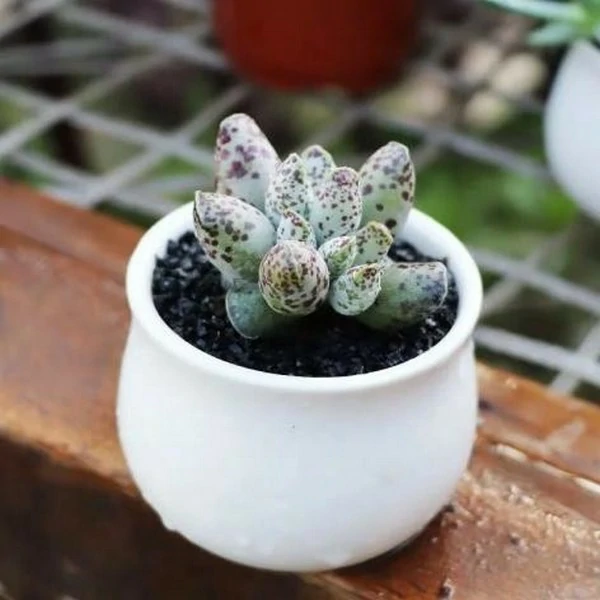
养护 : Maintenance:
景天类多肉植物都具有独特的外观和生长习性,适合不同的养殖环境和养殖者。在选择和养殖景天类多肉植物时,需要注意以下几点:
Crassulaceae succulents all have unique appearances and growth habits, suitable for different breeding environments and breeders. When choosing and breeding Sedum succulents, you need to pay attention to the following points:
- 光照:景天类多肉植物大多喜欢充足的阳光,但在夏季高温时,部分品种需要适当遮阴,以避免叶片晒伤。
- Light: Most Crassulaceaesucculents prefer plenty of sunlight, but during the high temperatures in summer, some varieties need proper shade to avoid sunburn of the leaves.
- 温度:适宜生长温度通常在10-30℃之间,冬季应注意保暖,避免长时间处于5℃以下的低温环境。
- Temperature: The suitable growth temperature is usually between 10-30℃. In winter, you should keep warm and avoid being in a low temperature environment below 5℃ for a long time.
- 通风:良好的通风条件有助于减少病虫害的发生,同时也有利于植物的呼吸和水分蒸发。
- Ventilation: Good ventilation conditions help reduce the occurrence of diseases and pests, and are also beneficial to plant respiration and water evaporation.
- 浇水:遵循“见干见湿”的原则,即等到土壤表面干燥后再浇水,浇水要浇透。夏季高温时,减少浇水频率,避免积水导致根部腐烂;冬季气温较低时,也要控制浇水,保持土壤适度干燥。
- Watering: follow the principle of “water when dry and water when wet”, that is, wait until the soil surface is dry before watering, and water thoroughly. In the summer when the temperature is high, reduce the frequency of watering to avoid water accumulation and root rot; in the winter when the temperature is low, also control watering and keep the soil moderately dry.
- 施肥:选择多肉植物专用的缓释肥,或者稀释后的液肥。生长季节每隔2-4周施肥一次,冬季和夏季高温时停止施肥。
- Fertilization: Choose a slow-release fertilizer for succulents, or a diluted liquid fertilizer. Fertilize every 2-4 weeks during the growing season, and stop fertilizing in winter and summer when the temperature is high.
- 病虫害防治:常见病害有黑腐病、白粉病等,发现病害要及时切除病株部分,并使用相应的杀菌剂进行防治。常见虫害有蚧壳虫、蚜虫等,可以使用杀虫剂进行喷杀,或者用棉签蘸酒精擦拭。
- Pest and disease control: Common diseases include black rot and powdery mildew. If a disease is found, the diseased part of the plant should be removed in time, and the corresponding fungicide should be used for prevention and control. Common insect pests include scale insects and aphids, which can be sprayed with insecticides or wiped with a cotton swab dipped in alcohol.
拟石莲花属多肉植物主要包括夏型种和冬型种,它们的养护方法有所不同。
夏型种养护方法
Echeveria succulents mainly include summer-type species and winter-type species, and their maintenance methods are different. Summer-type species maintenance methods:
温度:夏型种多肉植物适宜的生长温度为15~30℃,气温低于10℃或高于35℃时会短暂休眠。冬季需要放在阳光处见光保温防冻伤,夏季则需遮阴降温。
Temperature: The suitable growth temperature for summer-type succulents is 15-30℃. They will go dormant for a short time when the temperature is below 10℃ or above 35℃. In winter, they need to be placed in the sun to keep warm and prevent frostbite, while in summer, they need to be shaded and cooled.
光照:在生长旺盛期喜阳光充足,冬季要见光,夏季则需适当遮光,防止强光直射。
Light: It likes plenty of sunlight during the active growth period. It needs light in winter and proper shading in summer to prevent direct sunlight.
水分:耐干旱,干旱时要及时浇水,但不能积水,适宜的空气湿度为60%左右1。夏季生长期需要相对充足的水分,避免洒在叶片上,浇水时间以清晨为佳。
Water: Drought-resistant, water in time during drought, but no water accumulation, suitable air humidity is about 60% 1. Relatively sufficient water is needed during the summer growing season, avoid sprinkling on the leaves, and watering is best done in the early morning.
养分:在浇水时将养分溶解在水中,补充磷钾肥和微量元素,常用肥料有磷酸二氢钾和螯合铁。
Nutrients: Dissolve nutrients in water when watering, supplement phosphorus, potassium fertilizers and trace elements. Commonly used fertilizers include potassium dihydrogen phosphate and chelated iron.
冬型种养护方法 Winter type seed maintenance method
温度:冬型种多肉植物在冬季12℃以下时会有短暂的休眠期,期间暂停生长,最好移到室内明亮处保温。任何时候都应尽量将植物放在空气清凉流通的地方种植。
Temperature: Winter-type succulents will have a short dormant period when the temperature is below 12°C in winter, during which time they will stop growing. It is best to move them to a bright place indoors to keep warm. Plants should be planted in a cool and well-ventilated place at all times.
光照:虽然喜欢阳光充足的环境,但应避免午后的强烈阳光,冬季放在家里最亮的窗户附近。
Light: Although it likes a sunny environment, it should avoid strong afternoon sunlight and be placed near the brightest window in the home in winter.
水分:冬季生长缓慢,需减少浇水频率,保持土壤微湿即可。
Water: Growth is slow in winter, so you need to reduce the frequency of watering and keep the soil slightly moist.
养分:冬季生长缓慢,施肥量应减少或停止施肥。
Nutrients: Growth is slow in winter, so the amount of fertilizer should be reduced or stopped.
莲花掌属 Aeonium
产加那利和马达加斯加群岛Aenoium, cultivated from Canary Islands and Madagascar.
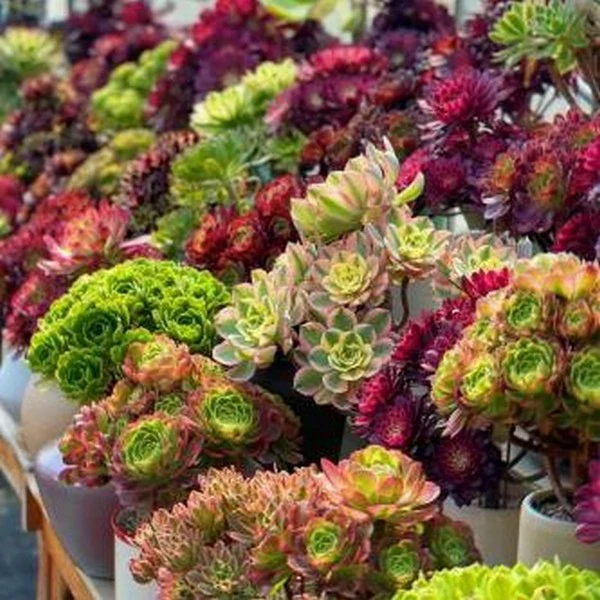
养护 : Maintenance:
景天类多肉植物都具有独特的外观和生长习性,适合不同的养殖环境和养殖者。在选择和养殖景天类多肉植物时,需要注意以下几点:
Crassulaceae succulents all have unique appearances and growth habits, suitable for different breeding environments and breeders. When choosing and breeding Sedum succulents, you need to pay attention to the following points:
- 光照:景天类多肉植物大多喜欢充足的阳光,但在夏季高温时,部分品种需要适当遮阴,以避免叶片晒伤。
- Light: Most Crassulaceaesucculents prefer plenty of sunlight, but during the high temperatures in summer, some varieties need proper shade to avoid sunburn of the leaves.
- 温度:适宜生长温度通常在10-30℃之间,冬季应注意保暖,避免长时间处于5℃以下的低温环境。
- Temperature: The suitable growth temperature is usually between 10-30℃. In winter, you should keep warm and avoid being in a low temperature environment below 5℃ for a long time.
- 通风:良好的通风条件有助于减少病虫害的发生,同时也有利于植物的呼吸和水分蒸发。
- Ventilation: Good ventilation conditions help reduce the occurrence of diseases and pests, and are also beneficial to plant respiration and water evaporation.
- 浇水:遵循“见干见湿”的原则,即等到土壤表面干燥后再浇水,浇水要浇透。夏季高温时,减少浇水频率,避免积水导致根部腐烂;冬季气温较低时,也要控制浇水,保持土壤适度干燥。
- Watering: follow the principle of “water when dry and water when wet”, that is, wait until the soil surface is dry before watering, and water thoroughly. In the summer when the temperature is high, reduce the frequency of watering to avoid water accumulation and root rot; in the winter when the temperature is low, also control watering and keep the soil moderately dry.
- 施肥:选择多肉植物专用的缓释肥,或者稀释后的液肥。生长季节每隔2-4周施肥一次,冬季和夏季高温时停止施肥。
- Fertilization: Choose a slow-release fertilizer for succulents, or a diluted liquid fertilizer. Fertilize every 2-4 weeks during the growing season, and stop fertilizing in winter and summer when the temperature is high.
- 病虫害防治:常见病害有黑腐病、白粉病等,发现病害要及时切除病株部分,并使用相应的杀菌剂进行防治。常见虫害有蚧壳虫、蚜虫等,可以使用杀虫剂进行喷杀,或者用棉签蘸酒精擦拭。
- Pest and disease control: Common diseases include black rot and powdery mildew. If a disease is found, the diseased part of the plant should be removed in time, and the corresponding fungicide should be used for prevention and control. Common insect pests include scale insects and aphids, which can be sprayed with insecticides or wiped with a cotton swab dipped in alcohol.
拟石莲花属多肉植物主要包括夏型种和冬型种,它们的养护方法有所不同。
夏型种养护方法
Echeveria succulents mainly include summer-type species and winter-type species, and their maintenance methods are different. Summer-type species maintenance methods:
温度:夏型种多肉植物适宜的生长温度为15~30℃,气温低于10℃或高于35℃时会短暂休眠。冬季需要放在阳光处见光保温防冻伤,夏季则需遮阴降温。
Temperature: The suitable growth temperature for summer-type succulents is 15-30℃. They will go dormant for a short time when the temperature is below 10℃ or above 35℃. In winter, they need to be placed in the sun to keep warm and prevent frostbite, while in summer, they need to be shaded and cooled.
光照:在生长旺盛期喜阳光充足,冬季要见光,夏季则需适当遮光,防止强光直射。
Light: It likes plenty of sunlight during the active growth period. It needs light in winter and proper shading in summer to prevent direct sunlight.
水分:耐干旱,干旱时要及时浇水,但不能积水,适宜的空气湿度为60%左右1。夏季生长期需要相对充足的水分,避免洒在叶片上,浇水时间以清晨为佳。
Water: Drought-resistant, water in time during drought, but no water accumulation, suitable air humidity is about 60% 1. Relatively sufficient water is needed during the summer growing season, avoid sprinkling on the leaves, and watering is best done in the early morning.
养分:在浇水时将养分溶解在水中,补充磷钾肥和微量元素,常用肥料有磷酸二氢钾和螯合铁。
Nutrients: Dissolve nutrients in water when watering, supplement phosphorus, potassium fertilizers and trace elements. Commonly used fertilizers include potassium dihydrogen phosphate and chelated iron.
冬型种养护方法 Winter type seed maintenance method
温度:冬型种多肉植物在冬季12℃以下时会有短暂的休眠期,期间暂停生长,最好移到室内明亮处保温。任何时候都应尽量将植物放在空气清凉流通的地方种植。
Temperature: Winter-type succulents will have a short dormant period when the temperature is below 12°C in winter, during which time they will stop growing. It is best to move them to a bright place indoors to keep warm. Plants should be planted in a cool and well-ventilated place at all times.
光照:虽然喜欢阳光充足的环境,但应避免午后的强烈阳光,冬季放在家里最亮的窗户附近。
Light: Although it likes a sunny environment, it should avoid strong afternoon sunlight and be placed near the brightest window in the home in winter.
水分:冬季生长缓慢,需减少浇水频率,保持土壤微湿即可。
Water: Growth is slow in winter, so you need to reduce the frequency of watering and keep the soil slightly moist.
养分:冬季生长缓慢,施肥量应减少或停止施肥。
Nutrients: Growth is slow in winter, so the amount of fertilizer should be reduced or stopped.
银波锦属Cotyledon
产阿拉伯半岛、纳米比亚和南非。不具蜡的品种分出去成立了奇峰锦属Tylecodon Cotyledon, cultivated from Arabian Peninsula, Namibia and South Africa. The non-waxy variety was separated into the genus of Tylecodon.
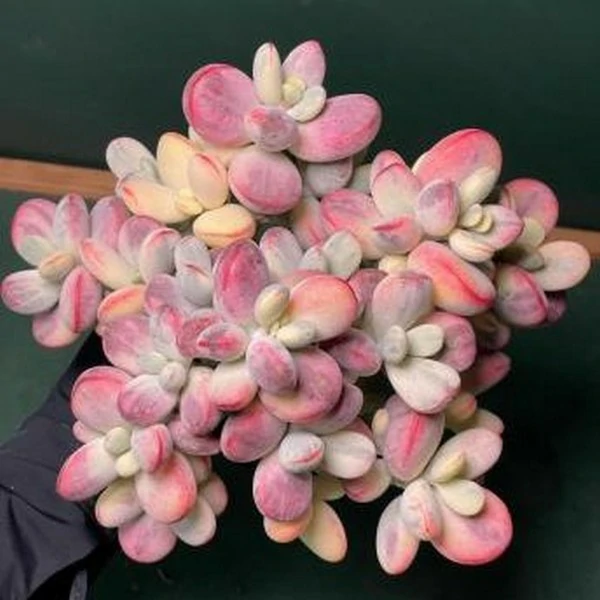
养护 : Maintenance:
景天类多肉植物都具有独特的外观和生长习性,适合不同的养殖环境和养殖者。在选择和养殖景天类多肉植物时,需要注意以下几点:
Crassulaceae succulents all have unique appearances and growth habits, suitable for different breeding environments and breeders. When choosing and breeding Sedum succulents, you need to pay attention to the following points:
- 光照:景天类多肉植物大多喜欢充足的阳光,但在夏季高温时,部分品种需要适当遮阴,以避免叶片晒伤。
- Light: Most Crassulaceaesucculents prefer plenty of sunlight, but during the high temperatures in summer, some varieties need proper shade to avoid sunburn of the leaves.
- 温度:适宜生长温度通常在10-30℃之间,冬季应注意保暖,避免长时间处于5℃以下的低温环境。
- Temperature: The suitable growth temperature is usually between 10-30℃. In winter, you should keep warm and avoid being in a low temperature environment below 5℃ for a long time.
- 通风:良好的通风条件有助于减少病虫害的发生,同时也有利于植物的呼吸和水分蒸发。
- Ventilation: Good ventilation conditions help reduce the occurrence of diseases and pests, and are also beneficial to plant respiration and water evaporation.
- 浇水:遵循“见干见湿”的原则,即等到土壤表面干燥后再浇水,浇水要浇透。夏季高温时,减少浇水频率,避免积水导致根部腐烂;冬季气温较低时,也要控制浇水,保持土壤适度干燥。
- Watering: follow the principle of “water when dry and water when wet”, that is, wait until the soil surface is dry before watering, and water thoroughly. In the summer when the temperature is high, reduce the frequency of watering to avoid water accumulation and root rot; in the winter when the temperature is low, also control watering and keep the soil moderately dry.
- 施肥:选择多肉植物专用的缓释肥,或者稀释后的液肥。生长季节每隔2-4周施肥一次,冬季和夏季高温时停止施肥。
- Fertilization: Choose a slow-release fertilizer for succulents, or a diluted liquid fertilizer. Fertilize every 2-4 weeks during the growing season, and stop fertilizing in winter and summer when the temperature is high.
- 病虫害防治:常见病害有黑腐病、白粉病等,发现病害要及时切除病株部分,并使用相应的杀菌剂进行防治。常见虫害有蚧壳虫、蚜虫等,可以使用杀虫剂进行喷杀,或者用棉签蘸酒精擦拭。
- Pest and disease control: Common diseases include black rot and powdery mildew. If a disease is found, the diseased part of the plant should be removed in time, and the corresponding fungicide should be used for prevention and control. Common insect pests include scale insects and aphids, which can be sprayed with insecticides or wiped with a cotton swab dipped in alcohol.
拟石莲花属多肉植物主要包括夏型种和冬型种,它们的养护方法有所不同。
夏型种养护方法
Echeveria succulents mainly include summer-type species and winter-type species, and their maintenance methods are different. Summer-type species maintenance methods:
温度:夏型种多肉植物适宜的生长温度为15~30℃,气温低于10℃或高于35℃时会短暂休眠。冬季需要放在阳光处见光保温防冻伤,夏季则需遮阴降温。
Temperature: The suitable growth temperature for summer-type succulents is 15-30℃. They will go dormant for a short time when the temperature is below 10℃ or above 35℃. In winter, they need to be placed in the sun to keep warm and prevent frostbite, while in summer, they need to be shaded and cooled.
光照:在生长旺盛期喜阳光充足,冬季要见光,夏季则需适当遮光,防止强光直射。
Light: It likes plenty of sunlight during the active growth period. It needs light in winter and proper shading in summer to prevent direct sunlight.
水分:耐干旱,干旱时要及时浇水,但不能积水,适宜的空气湿度为60%左右1。夏季生长期需要相对充足的水分,避免洒在叶片上,浇水时间以清晨为佳。
Water: Drought-resistant, water in time during drought, but no water accumulation, suitable air humidity is about 60% 1. Relatively sufficient water is needed during the summer growing season, avoid sprinkling on the leaves, and watering is best done in the early morning.
养分:在浇水时将养分溶解在水中,补充磷钾肥和微量元素,常用肥料有磷酸二氢钾和螯合铁。
Nutrients: Dissolve nutrients in water when watering, supplement phosphorus, potassium fertilizers and trace elements. Commonly used fertilizers include potassium dihydrogen phosphate and chelated iron.
冬型种养护方法 Winter type seed maintenance method
温度:冬型种多肉植物在冬季12℃以下时会有短暂的休眠期,期间暂停生长,最好移到室内明亮处保温。任何时候都应尽量将植物放在空气清凉流通的地方种植。
Temperature: Winter-type succulents will have a short dormant period when the temperature is below 12°C in winter, during which time they will stop growing. It is best to move them to a bright place indoors to keep warm. Plants should be planted in a cool and well-ventilated place at all times.
光照:虽然喜欢阳光充足的环境,但应避免午后的强烈阳光,冬季放在家里最亮的窗户附近。
Light: Although it likes a sunny environment, it should avoid strong afternoon sunlight and be placed near the brightest window in the home in winter.
水分:冬季生长缓慢,需减少浇水频率,保持土壤微湿即可。
Water: Growth is slow in winter, so you need to reduce the frequency of watering and keep the soil slightly moist.
养分:冬季生长缓慢,施肥量应减少或停止施肥。
Nutrients: Growth is slow in winter, so the amount of fertilizer should be reduced or stopped.
青锁龙属 Crassula
广布全球Crassula, cultivated in worldwide.
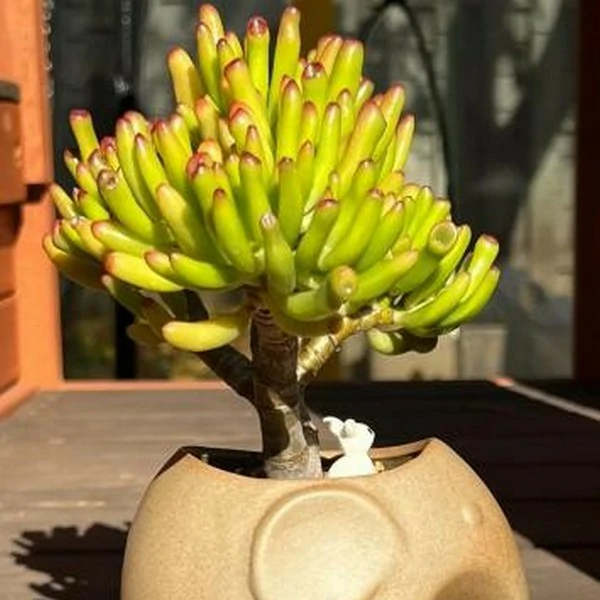
养护 : Maintenance:
景天类多肉植物都具有独特的外观和生长习性,适合不同的养殖环境和养殖者。在选择和养殖景天类多肉植物时,需要注意以下几点:
Crassulaceae succulents all have unique appearances and growth habits, suitable for different breeding environments and breeders. When choosing and breeding Sedum succulents, you need to pay attention to the following points:
- 光照:景天类多肉植物大多喜欢充足的阳光,但在夏季高温时,部分品种需要适当遮阴,以避免叶片晒伤。
- Light: Most Crassulaceaesucculents prefer plenty of sunlight, but during the high temperatures in summer, some varieties need proper shade to avoid sunburn of the leaves.
- 温度:适宜生长温度通常在10-30℃之间,冬季应注意保暖,避免长时间处于5℃以下的低温环境。
- Temperature: The suitable growth temperature is usually between 10-30℃. In winter, you should keep warm and avoid being in a low temperature environment below 5℃ for a long time.
- 通风:良好的通风条件有助于减少病虫害的发生,同时也有利于植物的呼吸和水分蒸发。
- Ventilation: Good ventilation conditions help reduce the occurrence of diseases and pests, and are also beneficial to plant respiration and water evaporation.
- 浇水:遵循“见干见湿”的原则,即等到土壤表面干燥后再浇水,浇水要浇透。夏季高温时,减少浇水频率,避免积水导致根部腐烂;冬季气温较低时,也要控制浇水,保持土壤适度干燥。
- Watering: follow the principle of “water when dry and water when wet”, that is, wait until the soil surface is dry before watering, and water thoroughly. In the summer when the temperature is high, reduce the frequency of watering to avoid water accumulation and root rot; in the winter when the temperature is low, also control watering and keep the soil moderately dry.
- 施肥:选择多肉植物专用的缓释肥,或者稀释后的液肥。生长季节每隔2-4周施肥一次,冬季和夏季高温时停止施肥。
- Fertilization: Choose a slow-release fertilizer for succulents, or a diluted liquid fertilizer. Fertilize every 2-4 weeks during the growing season, and stop fertilizing in winter and summer when the temperature is high.
- 病虫害防治:常见病害有黑腐病、白粉病等,发现病害要及时切除病株部分,并使用相应的杀菌剂进行防治。常见虫害有蚧壳虫、蚜虫等,可以使用杀虫剂进行喷杀,或者用棉签蘸酒精擦拭。
- Pest and disease control: Common diseases include black rot and powdery mildew. If a disease is found, the diseased part of the plant should be removed in time, and the corresponding fungicide should be used for prevention and control. Common insect pests include scale insects and aphids, which can be sprayed with insecticides or wiped with a cotton swab dipped in alcohol.
拟石莲花属多肉植物主要包括夏型种和冬型种,它们的养护方法有所不同。
夏型种养护方法
Echeveria succulents mainly include summer-type species and winter-type species, and their maintenance methods are different. Summer-type species maintenance methods:
温度:夏型种多肉植物适宜的生长温度为15~30℃,气温低于10℃或高于35℃时会短暂休眠。冬季需要放在阳光处见光保温防冻伤,夏季则需遮阴降温。
Temperature: The suitable growth temperature for summer-type succulents is 15-30℃. They will go dormant for a short time when the temperature is below 10℃ or above 35℃. In winter, they need to be placed in the sun to keep warm and prevent frostbite, while in summer, they need to be shaded and cooled.
光照:在生长旺盛期喜阳光充足,冬季要见光,夏季则需适当遮光,防止强光直射。
Light: It likes plenty of sunlight during the active growth period. It needs light in winter and proper shading in summer to prevent direct sunlight.
水分:耐干旱,干旱时要及时浇水,但不能积水,适宜的空气湿度为60%左右1。夏季生长期需要相对充足的水分,避免洒在叶片上,浇水时间以清晨为佳。
Water: Drought-resistant, water in time during drought, but no water accumulation, suitable air humidity is about 60% 1. Relatively sufficient water is needed during the summer growing season, avoid sprinkling on the leaves, and watering is best done in the early morning.
养分:在浇水时将养分溶解在水中,补充磷钾肥和微量元素,常用肥料有磷酸二氢钾和螯合铁。
Nutrients: Dissolve nutrients in water when watering, supplement phosphorus, potassium fertilizers and trace elements. Commonly used fertilizers include potassium dihydrogen phosphate and chelated iron.
冬型种养护方法 Winter type seed maintenance method
温度:冬型种多肉植物在冬季12℃以下时会有短暂的休眠期,期间暂停生长,最好移到室内明亮处保温。任何时候都应尽量将植物放在空气清凉流通的地方种植。
Temperature: Winter-type succulents will have a short dormant period when the temperature is below 12°C in winter, during which time they will stop growing. It is best to move them to a bright place indoors to keep warm. Plants should be planted in a cool and well-ventilated place at all times.
光照:虽然喜欢阳光充足的环境,但应避免午后的强烈阳光,冬季放在家里最亮的窗户附近。
Light: Although it likes a sunny environment, it should avoid strong afternoon sunlight and be placed near the brightest window in the home in winter.
水分:冬季生长缓慢,需减少浇水频率,保持土壤微湿即可。
Water: Growth is slow in winter, so you need to reduce the frequency of watering and keep the soil slightly moist.
养分:冬季生长缓慢,施肥量应减少或停止施肥。
Nutrients: Growth is slow in winter, so the amount of fertilizer should be reduced or stopped.
仙女杯属 Dudleya
产美国和墨西哥Dudleya, cultivated from America and Mexico.
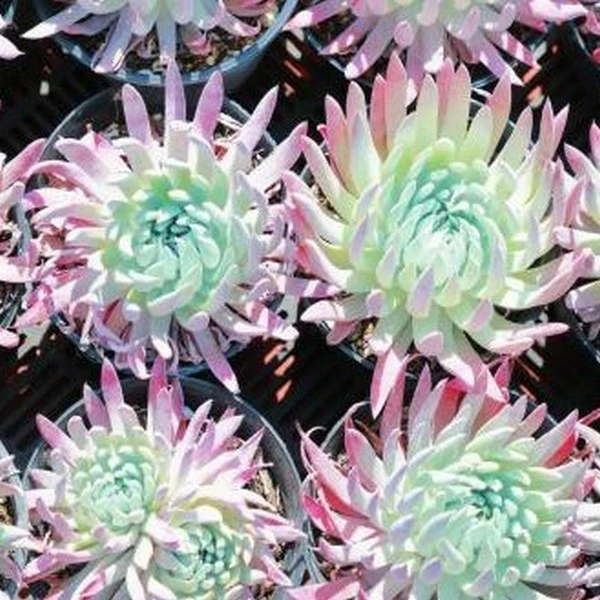
养护 : Maintenance:
景天类多肉植物都具有独特的外观和生长习性,适合不同的养殖环境和养殖者。在选择和养殖景天类多肉植物时,需要注意以下几点:
Crassulaceae succulents all have unique appearances and growth habits, suitable for different breeding environments and breeders. When choosing and breeding Sedum succulents, you need to pay attention to the following points:
- 光照:景天类多肉植物大多喜欢充足的阳光,但在夏季高温时,部分品种需要适当遮阴,以避免叶片晒伤。
- Light: Most Crassulaceaesucculents prefer plenty of sunlight, but during the high temperatures in summer, some varieties need proper shade to avoid sunburn of the leaves.
- 温度:适宜生长温度通常在10-30℃之间,冬季应注意保暖,避免长时间处于5℃以下的低温环境。
- Temperature: The suitable growth temperature is usually between 10-30℃. In winter, you should keep warm and avoid being in a low temperature environment below 5℃ for a long time.
- 通风:良好的通风条件有助于减少病虫害的发生,同时也有利于植物的呼吸和水分蒸发。
- Ventilation: Good ventilation conditions help reduce the occurrence of diseases and pests, and are also beneficial to plant respiration and water evaporation.
- 浇水:遵循“见干见湿”的原则,即等到土壤表面干燥后再浇水,浇水要浇透。夏季高温时,减少浇水频率,避免积水导致根部腐烂;冬季气温较低时,也要控制浇水,保持土壤适度干燥。
- Watering: follow the principle of “water when dry and water when wet”, that is, wait until the soil surface is dry before watering, and water thoroughly. In the summer when the temperature is high, reduce the frequency of watering to avoid water accumulation and root rot; in the winter when the temperature is low, also control watering and keep the soil moderately dry.
- 施肥:选择多肉植物专用的缓释肥,或者稀释后的液肥。生长季节每隔2-4周施肥一次,冬季和夏季高温时停止施肥。
- Fertilization: Choose a slow-release fertilizer for succulents, or a diluted liquid fertilizer. Fertilize every 2-4 weeks during the growing season, and stop fertilizing in winter and summer when the temperature is high.
- 病虫害防治:常见病害有黑腐病、白粉病等,发现病害要及时切除病株部分,并使用相应的杀菌剂进行防治。常见虫害有蚧壳虫、蚜虫等,可以使用杀虫剂进行喷杀,或者用棉签蘸酒精擦拭。
- Pest and disease control: Common diseases include black rot and powdery mildew. If a disease is found, the diseased part of the plant should be removed in time, and the corresponding fungicide should be used for prevention and control. Common insect pests include scale insects and aphids, which can be sprayed with insecticides or wiped with a cotton swab dipped in alcohol.
拟石莲花属多肉植物主要包括夏型种和冬型种,它们的养护方法有所不同。
夏型种养护方法
Echeveria succulents mainly include summer-type species and winter-type species, and their maintenance methods are different. Summer-type species maintenance methods:
温度:夏型种多肉植物适宜的生长温度为15~30℃,气温低于10℃或高于35℃时会短暂休眠。冬季需要放在阳光处见光保温防冻伤,夏季则需遮阴降温。
Temperature: The suitable growth temperature for summer-type succulents is 15-30℃. They will go dormant for a short time when the temperature is below 10℃ or above 35℃. In winter, they need to be placed in the sun to keep warm and prevent frostbite, while in summer, they need to be shaded and cooled.
光照:在生长旺盛期喜阳光充足,冬季要见光,夏季则需适当遮光,防止强光直射。
Light: It likes plenty of sunlight during the active growth period. It needs light in winter and proper shading in summer to prevent direct sunlight.
水分:耐干旱,干旱时要及时浇水,但不能积水,适宜的空气湿度为60%左右1。夏季生长期需要相对充足的水分,避免洒在叶片上,浇水时间以清晨为佳。
Water: Drought-resistant, water in time during drought, but no water accumulation, suitable air humidity is about 60% 1. Relatively sufficient water is needed during the summer growing season, avoid sprinkling on the leaves, and watering is best done in the early morning.
养分:在浇水时将养分溶解在水中,补充磷钾肥和微量元素,常用肥料有磷酸二氢钾和螯合铁。
Nutrients: Dissolve nutrients in water when watering, supplement phosphorus, potassium fertilizers and trace elements. Commonly used fertilizers include potassium dihydrogen phosphate and chelated iron.
冬型种养护方法 Winter type seed maintenance method
温度:冬型种多肉植物在冬季12℃以下时会有短暂的休眠期,期间暂停生长,最好移到室内明亮处保温。任何时候都应尽量将植物放在空气清凉流通的地方种植。
Temperature: Winter-type succulents will have a short dormant period when the temperature is below 12°C in winter, during which time they will stop growing. It is best to move them to a bright place indoors to keep warm. Plants should be planted in a cool and well-ventilated place at all times.
光照:虽然喜欢阳光充足的环境,但应避免午后的强烈阳光,冬季放在家里最亮的窗户附近。
Light: Although it likes a sunny environment, it should avoid strong afternoon sunlight and be placed near the brightest window in the home in winter.
水分:冬季生长缓慢,需减少浇水频率,保持土壤微湿即可。
Water: Growth is slow in winter, so you need to reduce the frequency of watering and keep the soil slightly moist.
养分:冬季生长缓慢,施肥量应减少或停止施肥。
Nutrients: Growth is slow in winter, so the amount of fertilizer should be reduced or stopped.
石莲花属 Echeveria
夏季半休眠,约160种,产墨西哥和中美洲Echeveria, semi-dormant in summer, about 160 species, cultivated from Mexico and Central America.
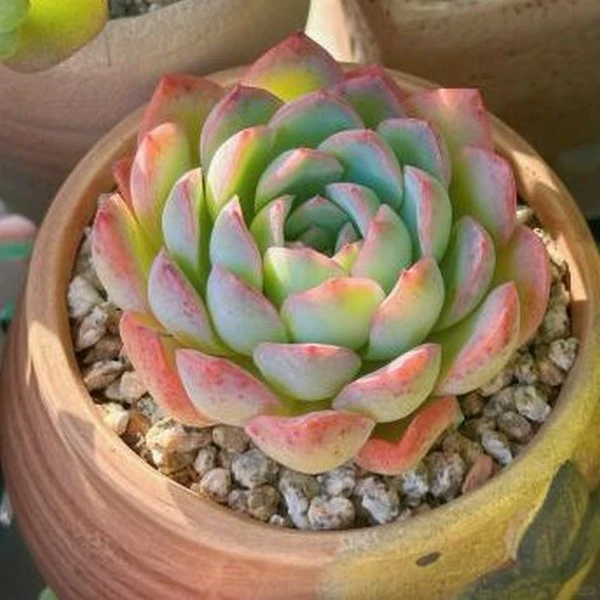
养护 : Maintenance:
景天类多肉植物都具有独特的外观和生长习性,适合不同的养殖环境和养殖者。在选择和养殖景天类多肉植物时,需要注意以下几点:
Crassulaceae succulents all have unique appearances and growth habits, suitable for different breeding environments and breeders. When choosing and breeding Sedum succulents, you need to pay attention to the following points:
- 光照:景天类多肉植物大多喜欢充足的阳光,但在夏季高温时,部分品种需要适当遮阴,以避免叶片晒伤。
- Light: Most Crassulaceaesucculents prefer plenty of sunlight, but during the high temperatures in summer, some varieties need proper shade to avoid sunburn of the leaves.
- 温度:适宜生长温度通常在10-30℃之间,冬季应注意保暖,避免长时间处于5℃以下的低温环境。
- Temperature: The suitable growth temperature is usually between 10-30℃. In winter, you should keep warm and avoid being in a low temperature environment below 5℃ for a long time.
- 通风:良好的通风条件有助于减少病虫害的发生,同时也有利于植物的呼吸和水分蒸发。
- Ventilation: Good ventilation conditions help reduce the occurrence of diseases and pests, and are also beneficial to plant respiration and water evaporation.
- 浇水:遵循“见干见湿”的原则,即等到土壤表面干燥后再浇水,浇水要浇透。夏季高温时,减少浇水频率,避免积水导致根部腐烂;冬季气温较低时,也要控制浇水,保持土壤适度干燥。
- Watering: follow the principle of “water when dry and water when wet”, that is, wait until the soil surface is dry before watering, and water thoroughly. In the summer when the temperature is high, reduce the frequency of watering to avoid water accumulation and root rot; in the winter when the temperature is low, also control watering and keep the soil moderately dry.
- 施肥:选择多肉植物专用的缓释肥,或者稀释后的液肥。生长季节每隔2-4周施肥一次,冬季和夏季高温时停止施肥。
- Fertilization: Choose a slow-release fertilizer for succulents, or a diluted liquid fertilizer. Fertilize every 2-4 weeks during the growing season, and stop fertilizing in winter and summer when the temperature is high.
- 病虫害防治:常见病害有黑腐病、白粉病等,发现病害要及时切除病株部分,并使用相应的杀菌剂进行防治。常见虫害有蚧壳虫、蚜虫等,可以使用杀虫剂进行喷杀,或者用棉签蘸酒精擦拭。
- Pest and disease control: Common diseases include black rot and powdery mildew. If a disease is found, the diseased part of the plant should be removed in time, and the corresponding fungicide should be used for prevention and control. Common insect pests include scale insects and aphids, which can be sprayed with insecticides or wiped with a cotton swab dipped in alcohol.
拟石莲花属多肉植物主要包括夏型种和冬型种,它们的养护方法有所不同。
夏型种养护方法
Echeveria succulents mainly include summer-type species and winter-type species, and their maintenance methods are different. Summer-type species maintenance methods:
温度:夏型种多肉植物适宜的生长温度为15~30℃,气温低于10℃或高于35℃时会短暂休眠。冬季需要放在阳光处见光保温防冻伤,夏季则需遮阴降温。
Temperature: The suitable growth temperature for summer-type succulents is 15-30℃. They will go dormant for a short time when the temperature is below 10℃ or above 35℃. In winter, they need to be placed in the sun to keep warm and prevent frostbite, while in summer, they need to be shaded and cooled.
光照:在生长旺盛期喜阳光充足,冬季要见光,夏季则需适当遮光,防止强光直射。
Light: It likes plenty of sunlight during the active growth period. It needs light in winter and proper shading in summer to prevent direct sunlight.
水分:耐干旱,干旱时要及时浇水,但不能积水,适宜的空气湿度为60%左右1。夏季生长期需要相对充足的水分,避免洒在叶片上,浇水时间以清晨为佳。
Water: Drought-resistant, water in time during drought, but no water accumulation, suitable air humidity is about 60% 1. Relatively sufficient water is needed during the summer growing season, avoid sprinkling on the leaves, and watering is best done in the early morning.
养分:在浇水时将养分溶解在水中,补充磷钾肥和微量元素,常用肥料有磷酸二氢钾和螯合铁。
Nutrients: Dissolve nutrients in water when watering, supplement phosphorus, potassium fertilizers and trace elements. Commonly used fertilizers include potassium dihydrogen phosphate and chelated iron.
冬型种养护方法 Winter type seed maintenance method
温度:冬型种多肉植物在冬季12℃以下时会有短暂的休眠期,期间暂停生长,最好移到室内明亮处保温。任何时候都应尽量将植物放在空气清凉流通的地方种植。
Temperature: Winter-type succulents will have a short dormant period when the temperature is below 12°C in winter, during which time they will stop growing. It is best to move them to a bright place indoors to keep warm. Plants should be planted in a cool and well-ventilated place at all times.
光照:虽然喜欢阳光充足的环境,但应避免午后的强烈阳光,冬季放在家里最亮的窗户附近。
Light: Although it likes a sunny environment, it should avoid strong afternoon sunlight and be placed near the brightest window in the home in winter.
水分:冬季生长缓慢,需减少浇水频率,保持土壤微湿即可。
Water: Growth is slow in winter, so you need to reduce the frequency of watering and keep the soil slightly moist.
养分:冬季生长缓慢,施肥量应减少或停止施肥。
Nutrients: Growth is slow in winter, so the amount of fertilizer should be reduced or stopped.
风车草属 Graptopetalum
产墨西哥,本属跟石莲花属近似,花不是瓶状或钟状,而是星状. Graptopetalum, this genus is similar to the genus Echeveria, but the petals are star-shaped instead of bottle-shaped or bell-shaped.
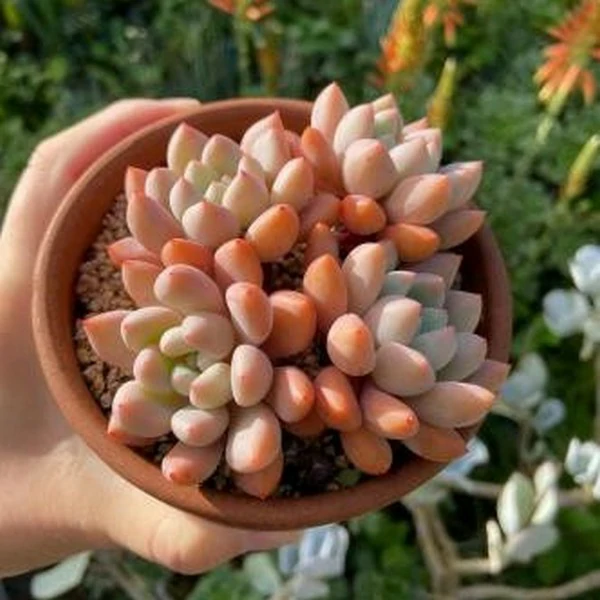
养护 : Maintenance:
景天类多肉植物都具有独特的外观和生长习性,适合不同的养殖环境和养殖者。在选择和养殖景天类多肉植物时,需要注意以下几点:
Crassulaceae succulents all have unique appearances and growth habits, suitable for different breeding environments and breeders. When choosing and breeding Sedum succulents, you need to pay attention to the following points:
- 光照:景天类多肉植物大多喜欢充足的阳光,但在夏季高温时,部分品种需要适当遮阴,以避免叶片晒伤。
- Light: Most Crassulaceaesucculents prefer plenty of sunlight, but during the high temperatures in summer, some varieties need proper shade to avoid sunburn of the leaves.
- 温度:适宜生长温度通常在10-30℃之间,冬季应注意保暖,避免长时间处于5℃以下的低温环境。
- Temperature: The suitable growth temperature is usually between 10-30℃. In winter, you should keep warm and avoid being in a low temperature environment below 5℃ for a long time.
- 通风:良好的通风条件有助于减少病虫害的发生,同时也有利于植物的呼吸和水分蒸发。
- Ventilation: Good ventilation conditions help reduce the occurrence of diseases and pests, and are also beneficial to plant respiration and water evaporation.
- 浇水:遵循“见干见湿”的原则,即等到土壤表面干燥后再浇水,浇水要浇透。夏季高温时,减少浇水频率,避免积水导致根部腐烂;冬季气温较低时,也要控制浇水,保持土壤适度干燥。
- Watering: follow the principle of “water when dry and water when wet”, that is, wait until the soil surface is dry before watering, and water thoroughly. In the summer when the temperature is high, reduce the frequency of watering to avoid water accumulation and root rot; in the winter when the temperature is low, also control watering and keep the soil moderately dry.
- 施肥:选择多肉植物专用的缓释肥,或者稀释后的液肥。生长季节每隔2-4周施肥一次,冬季和夏季高温时停止施肥。
- Fertilization: Choose a slow-release fertilizer for succulents, or a diluted liquid fertilizer. Fertilize every 2-4 weeks during the growing season, and stop fertilizing in winter and summer when the temperature is high.
- 病虫害防治:常见病害有黑腐病、白粉病等,发现病害要及时切除病株部分,并使用相应的杀菌剂进行防治。常见虫害有蚧壳虫、蚜虫等,可以使用杀虫剂进行喷杀,或者用棉签蘸酒精擦拭。
- Pest and disease control: Common diseases include black rot and powdery mildew. If a disease is found, the diseased part of the plant should be removed in time, and the corresponding fungicide should be used for prevention and control. Common insect pests include scale insects and aphids, which can be sprayed with insecticides or wiped with a cotton swab dipped in alcohol.
拟石莲花属多肉植物主要包括夏型种和冬型种,它们的养护方法有所不同。
夏型种养护方法
Echeveria succulents mainly include summer-type species and winter-type species, and their maintenance methods are different. Summer-type species maintenance methods:
温度:夏型种多肉植物适宜的生长温度为15~30℃,气温低于10℃或高于35℃时会短暂休眠。冬季需要放在阳光处见光保温防冻伤,夏季则需遮阴降温。
Temperature: The suitable growth temperature for summer-type succulents is 15-30℃. They will go dormant for a short time when the temperature is below 10℃ or above 35℃. In winter, they need to be placed in the sun to keep warm and prevent frostbite, while in summer, they need to be shaded and cooled.
光照:在生长旺盛期喜阳光充足,冬季要见光,夏季则需适当遮光,防止强光直射。
Light: It likes plenty of sunlight during the active growth period. It needs light in winter and proper shading in summer to prevent direct sunlight.
水分:耐干旱,干旱时要及时浇水,但不能积水,适宜的空气湿度为60%左右1。夏季生长期需要相对充足的水分,避免洒在叶片上,浇水时间以清晨为佳。
Water: Drought-resistant, water in time during drought, but no water accumulation, suitable air humidity is about 60% 1. Relatively sufficient water is needed during the summer growing season, avoid sprinkling on the leaves, and watering is best done in the early morning.
养分:在浇水时将养分溶解在水中,补充磷钾肥和微量元素,常用肥料有磷酸二氢钾和螯合铁。
Nutrients: Dissolve nutrients in water when watering, supplement phosphorus, potassium fertilizers and trace elements. Commonly used fertilizers include potassium dihydrogen phosphate and chelated iron.
冬型种养护方法 Winter type seed maintenance method
温度:冬型种多肉植物在冬季12℃以下时会有短暂的休眠期,期间暂停生长,最好移到室内明亮处保温。任何时候都应尽量将植物放在空气清凉流通的地方种植。
Temperature: Winter-type succulents will have a short dormant period when the temperature is below 12°C in winter, during which time they will stop growing. It is best to move them to a bright place indoors to keep warm. Plants should be planted in a cool and well-ventilated place at all times.
光照:虽然喜欢阳光充足的环境,但应避免午后的强烈阳光,冬季放在家里最亮的窗户附近。
Light: Although it likes a sunny environment, it should avoid strong afternoon sunlight and be placed near the brightest window in the home in winter.
水分:冬季生长缓慢,需减少浇水频率,保持土壤微湿即可。
Water: Growth is slow in winter, so you need to reduce the frequency of watering and keep the soil slightly moist.
养分:冬季生长缓慢,施肥量应减少或停止施肥。
Nutrients: Growth is slow in winter, so the amount of fertilizer should be reduced or stopped.
风车石莲属/Graptoveria
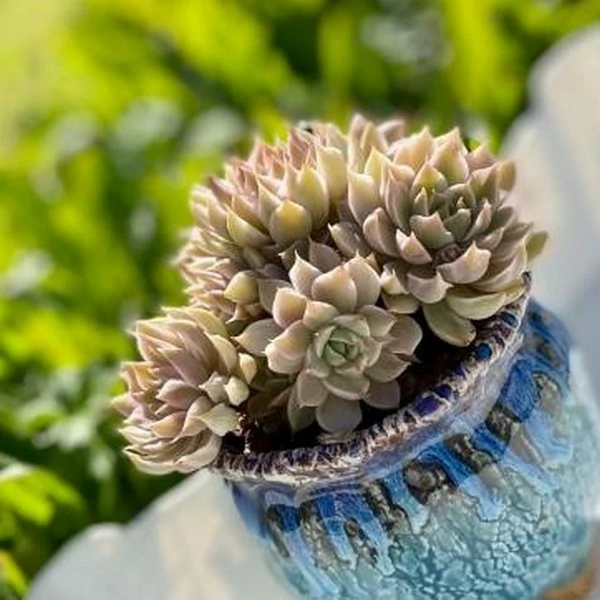
养护 : Maintenance:
景天类多肉植物都具有独特的外观和生长习性,适合不同的养殖环境和养殖者。在选择和养殖景天类多肉植物时,需要注意以下几点:
Crassulaceae succulents all have unique appearances and growth habits, suitable for different breeding environments and breeders. When choosing and breeding Sedum succulents, you need to pay attention to the following points:
- 光照:景天类多肉植物大多喜欢充足的阳光,但在夏季高温时,部分品种需要适当遮阴,以避免叶片晒伤。
- Light: Most Crassulaceaesucculents prefer plenty of sunlight, but during the high temperatures in summer, some varieties need proper shade to avoid sunburn of the leaves.
- 温度:适宜生长温度通常在10-30℃之间,冬季应注意保暖,避免长时间处于5℃以下的低温环境。
- Temperature: The suitable growth temperature is usually between 10-30℃. In winter, you should keep warm and avoid being in a low temperature environment below 5℃ for a long time.
- 通风:良好的通风条件有助于减少病虫害的发生,同时也有利于植物的呼吸和水分蒸发。
- Ventilation: Good ventilation conditions help reduce the occurrence of diseases and pests, and are also beneficial to plant respiration and water evaporation.
- 浇水:遵循“见干见湿”的原则,即等到土壤表面干燥后再浇水,浇水要浇透。夏季高温时,减少浇水频率,避免积水导致根部腐烂;冬季气温较低时,也要控制浇水,保持土壤适度干燥。
- Watering: follow the principle of “water when dry and water when wet”, that is, wait until the soil surface is dry before watering, and water thoroughly. In the summer when the temperature is high, reduce the frequency of watering to avoid water accumulation and root rot; in the winter when the temperature is low, also control watering and keep the soil moderately dry.
- 施肥:选择多肉植物专用的缓释肥,或者稀释后的液肥。生长季节每隔2-4周施肥一次,冬季和夏季高温时停止施肥。
- Fertilization: Choose a slow-release fertilizer for succulents, or a diluted liquid fertilizer. Fertilize every 2-4 weeks during the growing season, and stop fertilizing in winter and summer when the temperature is high.
- 病虫害防治:常见病害有黑腐病、白粉病等,发现病害要及时切除病株部分,并使用相应的杀菌剂进行防治。常见虫害有蚧壳虫、蚜虫等,可以使用杀虫剂进行喷杀,或者用棉签蘸酒精擦拭。
- Pest and disease control: Common diseases include black rot and powdery mildew. If a disease is found, the diseased part of the plant should be removed in time, and the corresponding fungicide should be used for prevention and control. Common insect pests include scale insects and aphids, which can be sprayed with insecticides or wiped with a cotton swab dipped in alcohol.
拟石莲花属多肉植物主要包括夏型种和冬型种,它们的养护方法有所不同。
夏型种养护方法
Echeveria succulents mainly include summer-type species and winter-type species, and their maintenance methods are different. Summer-type species maintenance methods:
温度:夏型种多肉植物适宜的生长温度为15~30℃,气温低于10℃或高于35℃时会短暂休眠。冬季需要放在阳光处见光保温防冻伤,夏季则需遮阴降温。
Temperature: The suitable growth temperature for summer-type succulents is 15-30℃. They will go dormant for a short time when the temperature is below 10℃ or above 35℃. In winter, they need to be placed in the sun to keep warm and prevent frostbite, while in summer, they need to be shaded and cooled.
光照:在生长旺盛期喜阳光充足,冬季要见光,夏季则需适当遮光,防止强光直射。
Light: It likes plenty of sunlight during the active growth period. It needs light in winter and proper shading in summer to prevent direct sunlight.
水分:耐干旱,干旱时要及时浇水,但不能积水,适宜的空气湿度为60%左右1。夏季生长期需要相对充足的水分,避免洒在叶片上,浇水时间以清晨为佳。
Water: Drought-resistant, water in time during drought, but no water accumulation, suitable air humidity is about 60% 1. Relatively sufficient water is needed during the summer growing season, avoid sprinkling on the leaves, and watering is best done in the early morning.
养分:在浇水时将养分溶解在水中,补充磷钾肥和微量元素,常用肥料有磷酸二氢钾和螯合铁。
Nutrients: Dissolve nutrients in water when watering, supplement phosphorus, potassium fertilizers and trace elements. Commonly used fertilizers include potassium dihydrogen phosphate and chelated iron.
冬型种养护方法 Winter type seed maintenance method
温度:冬型种多肉植物在冬季12℃以下时会有短暂的休眠期,期间暂停生长,最好移到室内明亮处保温。任何时候都应尽量将植物放在空气清凉流通的地方种植。
Temperature: Winter-type succulents will have a short dormant period when the temperature is below 12°C in winter, during which time they will stop growing. It is best to move them to a bright place indoors to keep warm. Plants should be planted in a cool and well-ventilated place at all times.
光照:虽然喜欢阳光充足的环境,但应避免午后的强烈阳光,冬季放在家里最亮的窗户附近。
Light: Although it likes a sunny environment, it should avoid strong afternoon sunlight and be placed near the brightest window in the home in winter.
水分:冬季生长缓慢,需减少浇水频率,保持土壤微湿即可。
Water: Growth is slow in winter, so you need to reduce the frequency of watering and keep the soil slightly moist.
养分:冬季生长缓慢,施肥量应减少或停止施肥。
Nutrients: Growth is slow in winter, so the amount of fertilizer should be reduced or stopped.
伽蓝菜属Kalanchoe
产马达加斯加和其他热带非洲,少数在亚洲Kalanchoe, most are native to Madagascar and other tropical Africa, with a few in Asia.
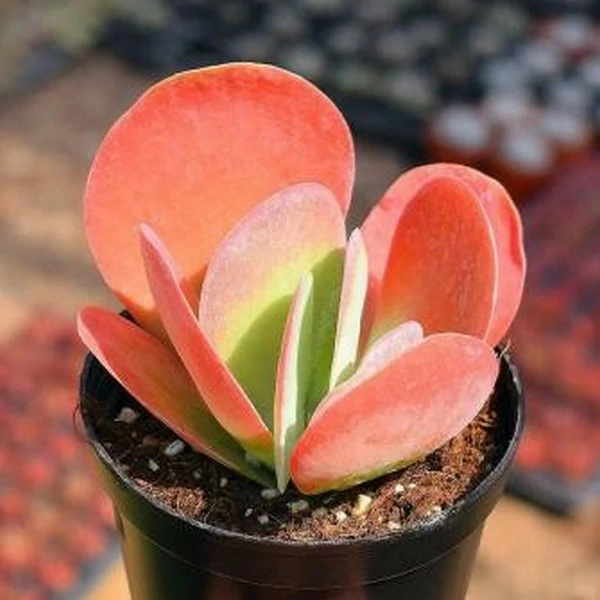
养护 : Maintenance:
景天类多肉植物都具有独特的外观和生长习性,适合不同的养殖环境和养殖者。在选择和养殖景天类多肉植物时,需要注意以下几点:
Crassulaceae succulents all have unique appearances and growth habits, suitable for different breeding environments and breeders. When choosing and breeding Sedum succulents, you need to pay attention to the following points:
- 光照:景天类多肉植物大多喜欢充足的阳光,但在夏季高温时,部分品种需要适当遮阴,以避免叶片晒伤。
- Light: Most Crassulaceaesucculents prefer plenty of sunlight, but during the high temperatures in summer, some varieties need proper shade to avoid sunburn of the leaves.
- 温度:适宜生长温度通常在10-30℃之间,冬季应注意保暖,避免长时间处于5℃以下的低温环境。
- Temperature: The suitable growth temperature is usually between 10-30℃. In winter, you should keep warm and avoid being in a low temperature environment below 5℃ for a long time.
- 通风:良好的通风条件有助于减少病虫害的发生,同时也有利于植物的呼吸和水分蒸发。
- Ventilation: Good ventilation conditions help reduce the occurrence of diseases and pests, and are also beneficial to plant respiration and water evaporation.
- 浇水:遵循“见干见湿”的原则,即等到土壤表面干燥后再浇水,浇水要浇透。夏季高温时,减少浇水频率,避免积水导致根部腐烂;冬季气温较低时,也要控制浇水,保持土壤适度干燥。
- Watering: follow the principle of “water when dry and water when wet”, that is, wait until the soil surface is dry before watering, and water thoroughly. In the summer when the temperature is high, reduce the frequency of watering to avoid water accumulation and root rot; in the winter when the temperature is low, also control watering and keep the soil moderately dry.
- 施肥:选择多肉植物专用的缓释肥,或者稀释后的液肥。生长季节每隔2-4周施肥一次,冬季和夏季高温时停止施肥。
- Fertilization: Choose a slow-release fertilizer for succulents, or a diluted liquid fertilizer. Fertilize every 2-4 weeks during the growing season, and stop fertilizing in winter and summer when the temperature is high.
- 病虫害防治:常见病害有黑腐病、白粉病等,发现病害要及时切除病株部分,并使用相应的杀菌剂进行防治。常见虫害有蚧壳虫、蚜虫等,可以使用杀虫剂进行喷杀,或者用棉签蘸酒精擦拭。
- Pest and disease control: Common diseases include black rot and powdery mildew. If a disease is found, the diseased part of the plant should be removed in time, and the corresponding fungicide should be used for prevention and control. Common insect pests include scale insects and aphids, which can be sprayed with insecticides or wiped with a cotton swab dipped in alcohol.
拟石莲花属多肉植物主要包括夏型种和冬型种,它们的养护方法有所不同。
夏型种养护方法
Echeveria succulents mainly include summer-type species and winter-type species, and their maintenance methods are different. Summer-type species maintenance methods:
温度:夏型种多肉植物适宜的生长温度为15~30℃,气温低于10℃或高于35℃时会短暂休眠。冬季需要放在阳光处见光保温防冻伤,夏季则需遮阴降温。
Temperature: The suitable growth temperature for summer-type succulents is 15-30℃. They will go dormant for a short time when the temperature is below 10℃ or above 35℃. In winter, they need to be placed in the sun to keep warm and prevent frostbite, while in summer, they need to be shaded and cooled.
光照:在生长旺盛期喜阳光充足,冬季要见光,夏季则需适当遮光,防止强光直射。
Light: It likes plenty of sunlight during the active growth period. It needs light in winter and proper shading in summer to prevent direct sunlight.
水分:耐干旱,干旱时要及时浇水,但不能积水,适宜的空气湿度为60%左右1。夏季生长期需要相对充足的水分,避免洒在叶片上,浇水时间以清晨为佳。
Water: Drought-resistant, water in time during drought, but no water accumulation, suitable air humidity is about 60% 1. Relatively sufficient water is needed during the summer growing season, avoid sprinkling on the leaves, and watering is best done in the early morning.
养分:在浇水时将养分溶解在水中,补充磷钾肥和微量元素,常用肥料有磷酸二氢钾和螯合铁。
Nutrients: Dissolve nutrients in water when watering, supplement phosphorus, potassium fertilizers and trace elements. Commonly used fertilizers include potassium dihydrogen phosphate and chelated iron.
冬型种养护方法 Winter type seed maintenance method
温度:冬型种多肉植物在冬季12℃以下时会有短暂的休眠期,期间暂停生长,最好移到室内明亮处保温。任何时候都应尽量将植物放在空气清凉流通的地方种植。
Temperature: Winter-type succulents will have a short dormant period when the temperature is below 12°C in winter, during which time they will stop growing. It is best to move them to a bright place indoors to keep warm. Plants should be planted in a cool and well-ventilated place at all times.
光照:虽然喜欢阳光充足的环境,但应避免午后的强烈阳光,冬季放在家里最亮的窗户附近。
Light: Although it likes a sunny environment, it should avoid strong afternoon sunlight and be placed near the brightest window in the home in winter.
水分:冬季生长缓慢,需减少浇水频率,保持土壤微湿即可。
Water: Growth is slow in winter, so you need to reduce the frequency of watering and keep the soil slightly moist.
养分:冬季生长缓慢,施肥量应减少或停止施肥。
Nutrients: Growth is slow in winter, so the amount of fertilizer should be reduced or stopped.
厚叶草属 Pachyphytum
产墨西哥Pachyphytum native in Mexico.
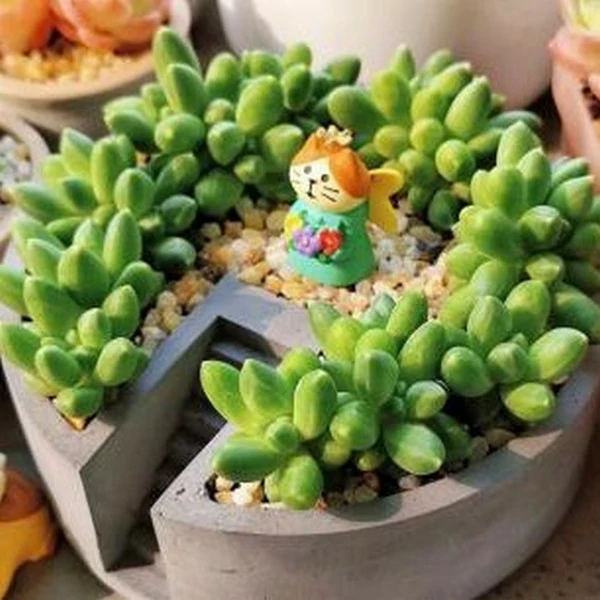
养护 : Maintenance:
景天类多肉植物都具有独特的外观和生长习性,适合不同的养殖环境和养殖者。在选择和养殖景天类多肉植物时,需要注意以下几点:
Crassulaceae succulents all have unique appearances and growth habits, suitable for different breeding environments and breeders. When choosing and breeding Sedum succulents, you need to pay attention to the following points:
- 光照:景天类多肉植物大多喜欢充足的阳光,但在夏季高温时,部分品种需要适当遮阴,以避免叶片晒伤。
- Light: Most Crassulaceaesucculents prefer plenty of sunlight, but during the high temperatures in summer, some varieties need proper shade to avoid sunburn of the leaves.
- 温度:适宜生长温度通常在10-30℃之间,冬季应注意保暖,避免长时间处于5℃以下的低温环境。
- Temperature: The suitable growth temperature is usually between 10-30℃. In winter, you should keep warm and avoid being in a low temperature environment below 5℃ for a long time.
- 通风:良好的通风条件有助于减少病虫害的发生,同时也有利于植物的呼吸和水分蒸发。
- Ventilation: Good ventilation conditions help reduce the occurrence of diseases and pests, and are also beneficial to plant respiration and water evaporation.
- 浇水:遵循“见干见湿”的原则,即等到土壤表面干燥后再浇水,浇水要浇透。夏季高温时,减少浇水频率,避免积水导致根部腐烂;冬季气温较低时,也要控制浇水,保持土壤适度干燥。
- Watering: follow the principle of “water when dry and water when wet”, that is, wait until the soil surface is dry before watering, and water thoroughly. In the summer when the temperature is high, reduce the frequency of watering to avoid water accumulation and root rot; in the winter when the temperature is low, also control watering and keep the soil moderately dry.
- 施肥:选择多肉植物专用的缓释肥,或者稀释后的液肥。生长季节每隔2-4周施肥一次,冬季和夏季高温时停止施肥。
- Fertilization: Choose a slow-release fertilizer for succulents, or a diluted liquid fertilizer. Fertilize every 2-4 weeks during the growing season, and stop fertilizing in winter and summer when the temperature is high.
- 病虫害防治:常见病害有黑腐病、白粉病等,发现病害要及时切除病株部分,并使用相应的杀菌剂进行防治。常见虫害有蚧壳虫、蚜虫等,可以使用杀虫剂进行喷杀,或者用棉签蘸酒精擦拭。
- Pest and disease control: Common diseases include black rot and powdery mildew. If a disease is found, the diseased part of the plant should be removed in time, and the corresponding fungicide should be used for prevention and control. Common insect pests include scale insects and aphids, which can be sprayed with insecticides or wiped with a cotton swab dipped in alcohol.
拟石莲花属多肉植物主要包括夏型种和冬型种,它们的养护方法有所不同。
夏型种养护方法
Echeveria succulents mainly include summer-type species and winter-type species, and their maintenance methods are different. Summer-type species maintenance methods:
温度:夏型种多肉植物适宜的生长温度为15~30℃,气温低于10℃或高于35℃时会短暂休眠。冬季需要放在阳光处见光保温防冻伤,夏季则需遮阴降温。
Temperature: The suitable growth temperature for summer-type succulents is 15-30℃. They will go dormant for a short time when the temperature is below 10℃ or above 35℃. In winter, they need to be placed in the sun to keep warm and prevent frostbite, while in summer, they need to be shaded and cooled.
光照:在生长旺盛期喜阳光充足,冬季要见光,夏季则需适当遮光,防止强光直射。
Light: It likes plenty of sunlight during the active growth period. It needs light in winter and proper shading in summer to prevent direct sunlight.
水分:耐干旱,干旱时要及时浇水,但不能积水,适宜的空气湿度为60%左右1。夏季生长期需要相对充足的水分,避免洒在叶片上,浇水时间以清晨为佳。
Water: Drought-resistant, water in time during drought, but no water accumulation, suitable air humidity is about 60% 1. Relatively sufficient water is needed during the summer growing season, avoid sprinkling on the leaves, and watering is best done in the early morning.
养分:在浇水时将养分溶解在水中,补充磷钾肥和微量元素,常用肥料有磷酸二氢钾和螯合铁。
Nutrients: Dissolve nutrients in water when watering, supplement phosphorus, potassium fertilizers and trace elements. Commonly used fertilizers include potassium dihydrogen phosphate and chelated iron.
冬型种养护方法 Winter type seed maintenance method
温度:冬型种多肉植物在冬季12℃以下时会有短暂的休眠期,期间暂停生长,最好移到室内明亮处保温。任何时候都应尽量将植物放在空气清凉流通的地方种植。
Temperature: Winter-type succulents will have a short dormant period when the temperature is below 12°C in winter, during which time they will stop growing. It is best to move them to a bright place indoors to keep warm. Plants should be planted in a cool and well-ventilated place at all times.
光照:虽然喜欢阳光充足的环境,但应避免午后的强烈阳光,冬季放在家里最亮的窗户附近。
Light: Although it likes a sunny environment, it should avoid strong afternoon sunlight and be placed near the brightest window in the home in winter.
水分:冬季生长缓慢,需减少浇水频率,保持土壤微湿即可。
Water: Growth is slow in winter, so you need to reduce the frequency of watering and keep the soil slightly moist.
养分:冬季生长缓慢,施肥量应减少或停止施肥。
Nutrients: Growth is slow in winter, so the amount of fertilizer should be reduced or stopped.
瓦松属 Rostachys
开花后抽花的叶盘枯死,由基部侧芽廷续后代,代表种富士、凤凰Orostachys, after flowering, the leaf disk of the flower dies, and the offspring continues from the lateral buds at the base. Representative varieties: Fuji, Iwerenge.
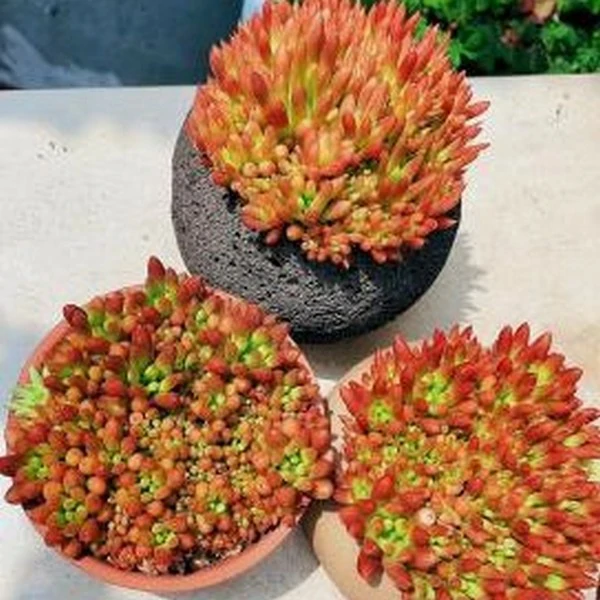
养护 : Maintenance:
景天类多肉植物都具有独特的外观和生长习性,适合不同的养殖环境和养殖者。在选择和养殖景天类多肉植物时,需要注意以下几点:
Crassulaceae succulents all have unique appearances and growth habits, suitable for different breeding environments and breeders. When choosing and breeding Sedum succulents, you need to pay attention to the following points:
- 光照:景天类多肉植物大多喜欢充足的阳光,但在夏季高温时,部分品种需要适当遮阴,以避免叶片晒伤。
- Light: Most Crassulaceaesucculents prefer plenty of sunlight, but during the high temperatures in summer, some varieties need proper shade to avoid sunburn of the leaves.
- 温度:适宜生长温度通常在10-30℃之间,冬季应注意保暖,避免长时间处于5℃以下的低温环境。
- Temperature: The suitable growth temperature is usually between 10-30℃. In winter, you should keep warm and avoid being in a low temperature environment below 5℃ for a long time.
- 通风:良好的通风条件有助于减少病虫害的发生,同时也有利于植物的呼吸和水分蒸发。
- Ventilation: Good ventilation conditions help reduce the occurrence of diseases and pests, and are also beneficial to plant respiration and water evaporation.
- 浇水:遵循“见干见湿”的原则,即等到土壤表面干燥后再浇水,浇水要浇透。夏季高温时,减少浇水频率,避免积水导致根部腐烂;冬季气温较低时,也要控制浇水,保持土壤适度干燥。
- Watering: follow the principle of “water when dry and water when wet”, that is, wait until the soil surface is dry before watering, and water thoroughly. In the summer when the temperature is high, reduce the frequency of watering to avoid water accumulation and root rot; in the winter when the temperature is low, also control watering and keep the soil moderately dry.
- 施肥:选择多肉植物专用的缓释肥,或者稀释后的液肥。生长季节每隔2-4周施肥一次,冬季和夏季高温时停止施肥。
- Fertilization: Choose a slow-release fertilizer for succulents, or a diluted liquid fertilizer. Fertilize every 2-4 weeks during the growing season, and stop fertilizing in winter and summer when the temperature is high.
- 病虫害防治:常见病害有黑腐病、白粉病等,发现病害要及时切除病株部分,并使用相应的杀菌剂进行防治。常见虫害有蚧壳虫、蚜虫等,可以使用杀虫剂进行喷杀,或者用棉签蘸酒精擦拭。
- Pest and disease control: Common diseases include black rot and powdery mildew. If a disease is found, the diseased part of the plant should be removed in time, and the corresponding fungicide should be used for prevention and control. Common insect pests include scale insects and aphids, which can be sprayed with insecticides or wiped with a cotton swab dipped in alcohol.
拟石莲花属多肉植物主要包括夏型种和冬型种,它们的养护方法有所不同。
夏型种养护方法
Echeveria succulents mainly include summer-type species and winter-type species, and their maintenance methods are different. Summer-type species maintenance methods:
温度:夏型种多肉植物适宜的生长温度为15~30℃,气温低于10℃或高于35℃时会短暂休眠。冬季需要放在阳光处见光保温防冻伤,夏季则需遮阴降温。
Temperature: The suitable growth temperature for summer-type succulents is 15-30℃. They will go dormant for a short time when the temperature is below 10℃ or above 35℃. In winter, they need to be placed in the sun to keep warm and prevent frostbite, while in summer, they need to be shaded and cooled.
光照:在生长旺盛期喜阳光充足,冬季要见光,夏季则需适当遮光,防止强光直射。
Light: It likes plenty of sunlight during the active growth period. It needs light in winter and proper shading in summer to prevent direct sunlight.
水分:耐干旱,干旱时要及时浇水,但不能积水,适宜的空气湿度为60%左右1。夏季生长期需要相对充足的水分,避免洒在叶片上,浇水时间以清晨为佳。
Water: Drought-resistant, water in time during drought, but no water accumulation, suitable air humidity is about 60% 1. Relatively sufficient water is needed during the summer growing season, avoid sprinkling on the leaves, and watering is best done in the early morning.
养分:在浇水时将养分溶解在水中,补充磷钾肥和微量元素,常用肥料有磷酸二氢钾和螯合铁。
Nutrients: Dissolve nutrients in water when watering, supplement phosphorus, potassium fertilizers and trace elements. Commonly used fertilizers include potassium dihydrogen phosphate and chelated iron.
冬型种养护方法 Winter type seed maintenance method
温度:冬型种多肉植物在冬季12℃以下时会有短暂的休眠期,期间暂停生长,最好移到室内明亮处保温。任何时候都应尽量将植物放在空气清凉流通的地方种植。
Temperature: Winter-type succulents will have a short dormant period when the temperature is below 12°C in winter, during which time they will stop growing. It is best to move them to a bright place indoors to keep warm. Plants should be planted in a cool and well-ventilated place at all times.
光照:虽然喜欢阳光充足的环境,但应避免午后的强烈阳光,冬季放在家里最亮的窗户附近。
Light: Although it likes a sunny environment, it should avoid strong afternoon sunlight and be placed near the brightest window in the home in winter.
水分:冬季生长缓慢,需减少浇水频率,保持土壤微湿即可。
Water: Growth is slow in winter, so you need to reduce the frequency of watering and keep the soil slightly moist.
养分:冬季生长缓慢,施肥量应减少或停止施肥。
Nutrients: Growth is slow in winter, so the amount of fertilizer should be reduced or stopped.
景天属Sedum
分布于全球北温带和热带高山地区Sedum, distributed in northern temperate zones and tropical alpine regions around the world.
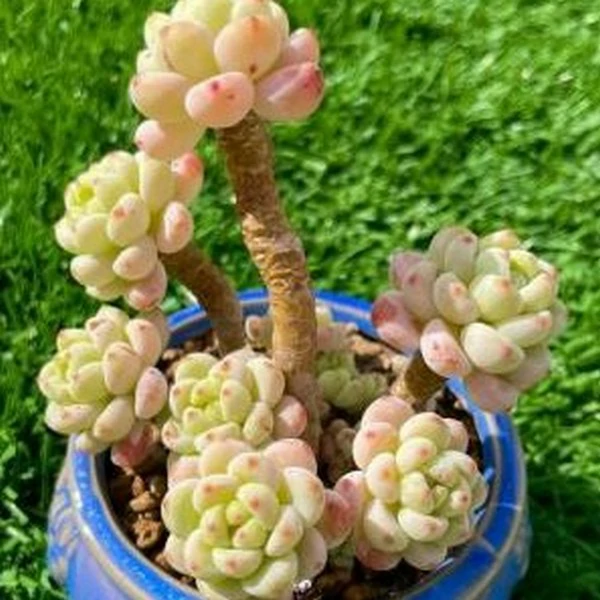
养护 : Maintenance:
景天类多肉植物都具有独特的外观和生长习性,适合不同的养殖环境和养殖者。在选择和养殖景天类多肉植物时,需要注意以下几点:
Crassulaceae succulents all have unique appearances and growth habits, suitable for different breeding environments and breeders. When choosing and breeding Sedum succulents, you need to pay attention to the following points:
- 光照:景天类多肉植物大多喜欢充足的阳光,但在夏季高温时,部分品种需要适当遮阴,以避免叶片晒伤。
- Light: Most Crassulaceaesucculents prefer plenty of sunlight, but during the high temperatures in summer, some varieties need proper shade to avoid sunburn of the leaves.
- 温度:适宜生长温度通常在10-30℃之间,冬季应注意保暖,避免长时间处于5℃以下的低温环境。
- Temperature: The suitable growth temperature is usually between 10-30℃. In winter, you should keep warm and avoid being in a low temperature environment below 5℃ for a long time.
- 通风:良好的通风条件有助于减少病虫害的发生,同时也有利于植物的呼吸和水分蒸发。
- Ventilation: Good ventilation conditions help reduce the occurrence of diseases and pests, and are also beneficial to plant respiration and water evaporation.
- 浇水:遵循“见干见湿”的原则,即等到土壤表面干燥后再浇水,浇水要浇透。夏季高温时,减少浇水频率,避免积水导致根部腐烂;冬季气温较低时,也要控制浇水,保持土壤适度干燥。
- Watering: follow the principle of “water when dry and water when wet”, that is, wait until the soil surface is dry before watering, and water thoroughly. In the summer when the temperature is high, reduce the frequency of watering to avoid water accumulation and root rot; in the winter when the temperature is low, also control watering and keep the soil moderately dry.
- 施肥:选择多肉植物专用的缓释肥,或者稀释后的液肥。生长季节每隔2-4周施肥一次,冬季和夏季高温时停止施肥。
- Fertilization: Choose a slow-release fertilizer for succulents, or a diluted liquid fertilizer. Fertilize every 2-4 weeks during the growing season, and stop fertilizing in winter and summer when the temperature is high.
- 病虫害防治:常见病害有黑腐病、白粉病等,发现病害要及时切除病株部分,并使用相应的杀菌剂进行防治。常见虫害有蚧壳虫、蚜虫等,可以使用杀虫剂进行喷杀,或者用棉签蘸酒精擦拭。
- Pest and disease control: Common diseases include black rot and powdery mildew. If a disease is found, the diseased part of the plant should be removed in time, and the corresponding fungicide should be used for prevention and control. Common insect pests include scale insects and aphids, which can be sprayed with insecticides or wiped with a cotton swab dipped in alcohol.
拟石莲花属多肉植物主要包括夏型种和冬型种,它们的养护方法有所不同。
夏型种养护方法
Echeveria succulents mainly include summer-type species and winter-type species, and their maintenance methods are different. Summer-type species maintenance methods:
温度:夏型种多肉植物适宜的生长温度为15~30℃,气温低于10℃或高于35℃时会短暂休眠。冬季需要放在阳光处见光保温防冻伤,夏季则需遮阴降温。
Temperature: The suitable growth temperature for summer-type succulents is 15-30℃. They will go dormant for a short time when the temperature is below 10℃ or above 35℃. In winter, they need to be placed in the sun to keep warm and prevent frostbite, while in summer, they need to be shaded and cooled.
光照:在生长旺盛期喜阳光充足,冬季要见光,夏季则需适当遮光,防止强光直射。
Light: It likes plenty of sunlight during the active growth period. It needs light in winter and proper shading in summer to prevent direct sunlight.
水分:耐干旱,干旱时要及时浇水,但不能积水,适宜的空气湿度为60%左右1。夏季生长期需要相对充足的水分,避免洒在叶片上,浇水时间以清晨为佳。
Water: Drought-resistant, water in time during drought, but no water accumulation, suitable air humidity is about 60% 1. Relatively sufficient water is needed during the summer growing season, avoid sprinkling on the leaves, and watering is best done in the early morning.
养分:在浇水时将养分溶解在水中,补充磷钾肥和微量元素,常用肥料有磷酸二氢钾和螯合铁。
Nutrients: Dissolve nutrients in water when watering, supplement phosphorus, potassium fertilizers and trace elements. Commonly used fertilizers include potassium dihydrogen phosphate and chelated iron.
冬型种养护方法 Winter type seed maintenance method
温度:冬型种多肉植物在冬季12℃以下时会有短暂的休眠期,期间暂停生长,最好移到室内明亮处保温。任何时候都应尽量将植物放在空气清凉流通的地方种植。
Temperature: Winter-type succulents will have a short dormant period when the temperature is below 12°C in winter, during which time they will stop growing. It is best to move them to a bright place indoors to keep warm. Plants should be planted in a cool and well-ventilated place at all times.
光照:虽然喜欢阳光充足的环境,但应避免午后的强烈阳光,冬季放在家里最亮的窗户附近。
Light: Although it likes a sunny environment, it should avoid strong afternoon sunlight and be placed near the brightest window in the home in winter.
水分:冬季生长缓慢,需减少浇水频率,保持土壤微湿即可。
Water: Growth is slow in winter, so you need to reduce the frequency of watering and keep the soil slightly moist.
养分:冬季生长缓慢,施肥量应减少或停止施肥。
Nutrients: Growth is slow in winter, so the amount of fertilizer should be reduced or stopped.
长生草属Sepervivum
产欧洲和北非,耐寒,部分品种夏天休眠Sepervivum, native to Europe and North Africa, cold-resistant, some varieties hibernate in summer.
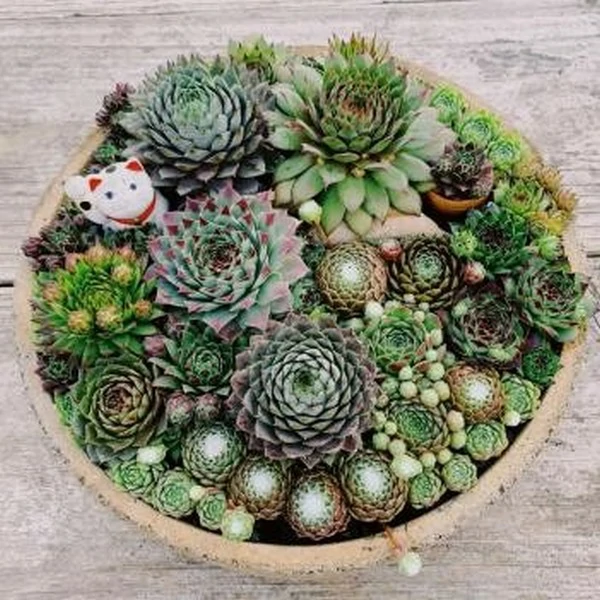
养护 : Maintenance:
景天类多肉植物都具有独特的外观和生长习性,适合不同的养殖环境和养殖者。在选择和养殖景天类多肉植物时,需要注意以下几点:
Crassulaceae succulents all have unique appearances and growth habits, suitable for different breeding environments and breeders. When choosing and breeding Sedum succulents, you need to pay attention to the following points:
- 光照:景天类多肉植物大多喜欢充足的阳光,但在夏季高温时,部分品种需要适当遮阴,以避免叶片晒伤。
- Light: Most Crassulaceaesucculents prefer plenty of sunlight, but during the high temperatures in summer, some varieties need proper shade to avoid sunburn of the leaves.
- 温度:适宜生长温度通常在10-30℃之间,冬季应注意保暖,避免长时间处于5℃以下的低温环境。
- Temperature: The suitable growth temperature is usually between 10-30℃. In winter, you should keep warm and avoid being in a low temperature environment below 5℃ for a long time.
- 通风:良好的通风条件有助于减少病虫害的发生,同时也有利于植物的呼吸和水分蒸发。
- Ventilation: Good ventilation conditions help reduce the occurrence of diseases and pests, and are also beneficial to plant respiration and water evaporation.
- 浇水:遵循“见干见湿”的原则,即等到土壤表面干燥后再浇水,浇水要浇透。夏季高温时,减少浇水频率,避免积水导致根部腐烂;冬季气温较低时,也要控制浇水,保持土壤适度干燥。
- Watering: follow the principle of “water when dry and water when wet”, that is, wait until the soil surface is dry before watering, and water thoroughly. In the summer when the temperature is high, reduce the frequency of watering to avoid water accumulation and root rot; in the winter when the temperature is low, also control watering and keep the soil moderately dry.
- 施肥:选择多肉植物专用的缓释肥,或者稀释后的液肥。生长季节每隔2-4周施肥一次,冬季和夏季高温时停止施肥。
- Fertilization: Choose a slow-release fertilizer for succulents, or a diluted liquid fertilizer. Fertilize every 2-4 weeks during the growing season, and stop fertilizing in winter and summer when the temperature is high.
- 病虫害防治:常见病害有黑腐病、白粉病等,发现病害要及时切除病株部分,并使用相应的杀菌剂进行防治。常见虫害有蚧壳虫、蚜虫等,可以使用杀虫剂进行喷杀,或者用棉签蘸酒精擦拭。
- Pest and disease control: Common diseases include black rot and powdery mildew. If a disease is found, the diseased part of the plant should be removed in time, and the corresponding fungicide should be used for prevention and control. Common insect pests include scale insects and aphids, which can be sprayed with insecticides or wiped with a cotton swab dipped in alcohol.
拟石莲花属多肉植物主要包括夏型种和冬型种,它们的养护方法有所不同。
夏型种养护方法
Echeveria succulents mainly include summer-type species and winter-type species, and their maintenance methods are different. Summer-type species maintenance methods:
温度:夏型种多肉植物适宜的生长温度为15~30℃,气温低于10℃或高于35℃时会短暂休眠。冬季需要放在阳光处见光保温防冻伤,夏季则需遮阴降温。
Temperature: The suitable growth temperature for summer-type succulents is 15-30℃. They will go dormant for a short time when the temperature is below 10℃ or above 35℃. In winter, they need to be placed in the sun to keep warm and prevent frostbite, while in summer, they need to be shaded and cooled.
光照:在生长旺盛期喜阳光充足,冬季要见光,夏季则需适当遮光,防止强光直射。
Light: It likes plenty of sunlight during the active growth period. It needs light in winter and proper shading in summer to prevent direct sunlight.
水分:耐干旱,干旱时要及时浇水,但不能积水,适宜的空气湿度为60%左右1。夏季生长期需要相对充足的水分,避免洒在叶片上,浇水时间以清晨为佳。
Water: Drought-resistant, water in time during drought, but no water accumulation, suitable air humidity is about 60% 1. Relatively sufficient water is needed during the summer growing season, avoid sprinkling on the leaves, and watering is best done in the early morning.
养分:在浇水时将养分溶解在水中,补充磷钾肥和微量元素,常用肥料有磷酸二氢钾和螯合铁。
Nutrients: Dissolve nutrients in water when watering, supplement phosphorus, potassium fertilizers and trace elements. Commonly used fertilizers include potassium dihydrogen phosphate and chelated iron.
冬型种养护方法 Winter type seed maintenance method
温度:冬型种多肉植物在冬季12℃以下时会有短暂的休眠期,期间暂停生长,最好移到室内明亮处保温。任何时候都应尽量将植物放在空气清凉流通的地方种植。
Temperature: Winter-type succulents will have a short dormant period when the temperature is below 12°C in winter, during which time they will stop growing. It is best to move them to a bright place indoors to keep warm. Plants should be planted in a cool and well-ventilated place at all times.
光照:虽然喜欢阳光充足的环境,但应避免午后的强烈阳光,冬季放在家里最亮的窗户附近。
Light: Although it likes a sunny environment, it should avoid strong afternoon sunlight and be placed near the brightest window in the home in winter.
水分:冬季生长缓慢,需减少浇水频率,保持土壤微湿即可。
Water: Growth is slow in winter, so you need to reduce the frequency of watering and keep the soil slightly moist.
养分:冬季生长缓慢,施肥量应减少或停止施肥。
Nutrients: Growth is slow in winter, so the amount of fertilizer should be reduced or stopped.
睡布袋属 Gerrardanthus
产非洲,仅2种errardanthus are native to Africa with only two types.
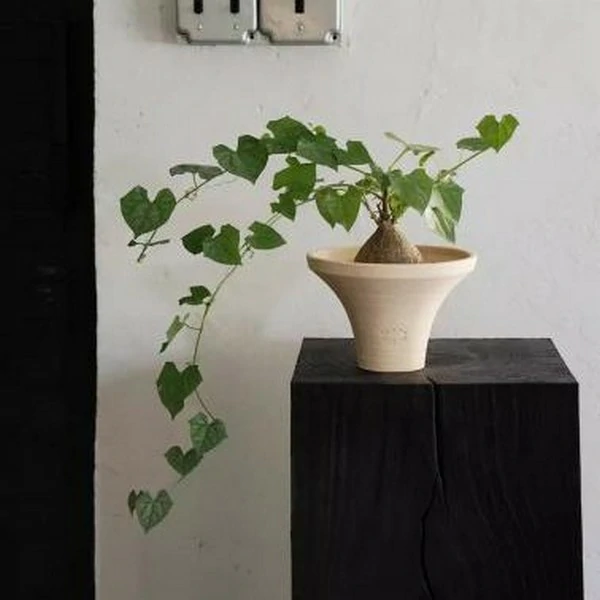
睡布袋属于“夏型种”,喜欢阳光充足、凉爽干燥的生长环境,耐干旱,不耐寒。
Gerrardanthus belongs to the “summer type”, like sunny, cool and dry growth environment. They are drought resistance, not cold resistance.
- 光照:睡布袋喜欢阳光充足的环境区要避免暴晒。冬天可以放在向阳处养护。
- Light: Gerrardanthuslikes the sunny environment area to avoid exposure to the sun.In winter, it can be kept in a sunny place
2.温度:睡布袋耐寒性较差,最佳生长温度为23-32°℃,冬季温度不宜低于5℃,否则会发生冻害 。
- Temperature: The cold resistance of Gerrardanthusis poorBest growth temperature is 23-32℃, and the winter temperature should not be lower than 5 ℃, otherwise freezing damage will occur.
3.浇水:睡布袋怕涝,土壤快干时再浇水,夏季需要额外补水,大约每周浇水一次。冬季保持盘土干燥即可
- Watering: Gerrardanthusis afraid of waterlogging, and then watering when the soil is almostdry. Extra water is needed in summer, about once a week. Keep the soil dry in winter
4.士壤:睡布袋需要良好的排水系统,全颗粒土是最合适的基质。
- Soil: Gerrardanthusneeds a good drainage system, and all-particle soil is the most suitable substrate.
5.繁殖:睡布袋主要以播种繁殖为主,成活率较低
- Propagation: Propagation of Gerrardanthus is maily done by seed sowing, with a relatively low surivival rate.
亚龙木属 Alluaudia
产马达加斯加Alluaudia cultivated in Madagascar.
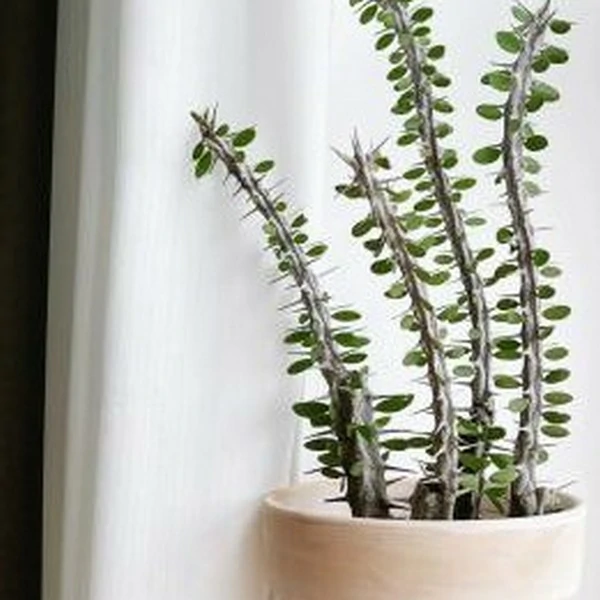
- 光照:亚龙木属多肉植物喜欢光照充足的环境,最好将其放置在阳光充足的地方进行养护。在生长期(4月至10月),应将植物放在外阳光充足处或内光线明亮处。盛夏高温时,虽然需要良好的通风,但不必遮光。
- Light:Like an environment with plenty of light, It is best to place it in a sunny place for maintenance. During the growing season (April to October),the plant should be placed in a sunny place outside or a bright place inside. During the high temperatures of midsummer, although good ventilation is required, but shading is not necessary.
- 温度和湿度:亚龙木属多肉植物适宜的生长温度为18-35℃℃,在0℃C以下容易遭受冻害它们比较耐旱,但在空气干燥时可以适量向植株喷水,以增加空气湿度,保持叶片肥厚碧绿
2.Temperature and Humidity: The suitable growth temperature is 18-35℃, They are susceptible to freezing damage below 0°C and relatively drought tolerant, But when the air is dry, you can spray water on the plants appropriately, to increase air humidity and keep leaves thick and green.
3.浇水:浇水应掌握”不干不浇,浇则浇透”的原则,避免盆土积水。春秋季保持土壤稍湿润,冬季则完全停止浇水,盆土保持干燥
3.Water:When watering, you should follow the principle of “don’t water unless the soil is dry, and water thoroughly when you do”,avoid waterlogging in the pot soil. Keep the soil slightly moist in spring and autumn,Stop watering completely in winter,Keep the soil dry.
4.换盘:每隔1-2年,在春季换一次盆,盆土要求疏松肥沃并具有较好的排水性,最好含有少量的石灰质。可用腐叶土、园土各1份,粗沙或蛭石2份的混合土,并掺入适量的骨粉草木灰等作基肥
4.Changing the pot: Change the pot every 1-2 years in spring. The potting soil should be loose, fertile and have good drainage, preferably containing a small amount of lime. You can use a mixture of 1 part leaf mold, 1 part garden soil, 2 parts coarse sand or vermiculite, and add an appropriate amount of bone meal and wood ash as base fertilizer.
5.繁殖方法:亚龙木多采取扦插繁殖。具体操作是在18-30℃的温度下,选取健壮充实的长5cm以上的枝条,切口晾干几天后,再将其插到砂土中,保持土壤稍湿润,极易生根。
- Propagationmethod: The cutting propagation is mostly adopted. The specific operation is at a temperature of 18-30℃, select strong and full branches that are more than 5cm long, After the cut has dried for a few days,then insert it into the sand,Keep the soil slightly moist, very easy to root.
薯蓣属/Dioscorea
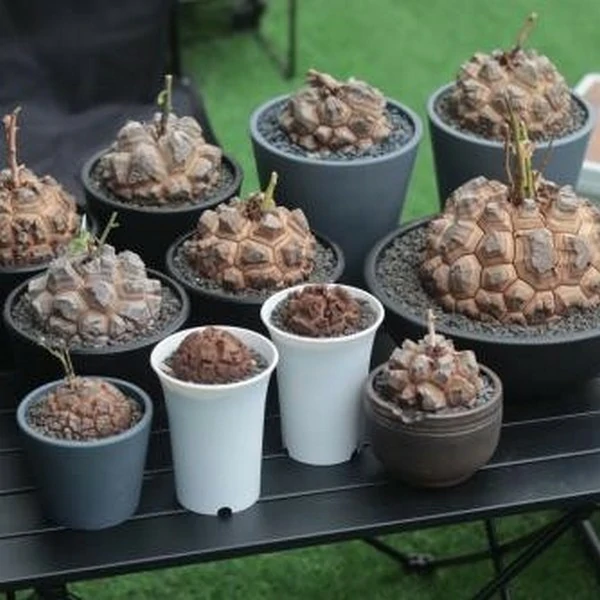
- 土壤选择:薯蓣属多肉植物适合中等肥力、透气排水的沙质土壤。土壤中不能含有过多的腐叶,否则容易导致烂根。播种时可以使用70%的泥炭和30%的颗粒土,而对于8cm以的植株,则可以使用30%的泥炭和70%的颗粒士,以确保土壤疏松透水
- Soil selection: Dioscorea succulents are suitable for sandy soil with medium fertility, air permeability and drainage. The soil should not contain too much rotten leaves, otherwise it will easily cause root rot. When sowing, you can use 70% peat and 30% granular soil, and for plants over 8cm, you can use 30% peat and 70% granular soil to ensure that the soil is loose and permeable.
2.浇水管理:薯蓣属多肉植物的浇水方式有多种选择,可以选择浸会法或一次性浇透的方法。在生长期,浇水频率较高,大约每10天左右浇透一次,或者小盆每周一次,但一定要避免积水。休眠期则不需要浇透,每月一次即可。冬季每隔4-7天浇水一次即可。
- Watering: There are many ways to water Dioscorea succulents, you can choose to soak or water it thoroughly at once. During the growing season, water more frequently, about once every 10 days, or once a week for small pots, but be sure to avoid water accumulation. During the dormant period, it is not necessary to water thoroughly, once a month is enough. In winter, water once every 4-7 days.
3.温度控制:适宜的温度对薯蓣属多肉的生长非常重要。适宜的生长温度为15°C-25℃℃,当温度下降到10℃左右时,生长速度会减缓,当温度下降到5℃左右时,可能会出现冻伤。冬季温度不应低于7°C。
3.Temperature control: Suitable temperature is very important for the growth of Dioscorea succulents. The suitable growth temperature is 15°C-25°C. When the temperature drops to around 10°C, the growth rate will slow down, and when the temperature drops to around 5°C, frostbite may occur. Th
4.施肥方法:薯蓣属多肉植物适合薄肥,平时控制使用频率,不可使用过浓的肥料。如果使用液体肥,需要提前将肥料与水按照1:50或1:75的比例稀释,一般每个月施肥1-2次即可
4.Fertilization method: Dioscorea succulents are suitable for liquid fertilizer. Control the frequency of use and do not use too concentrated fertilizer. If liquid fertilizer is used, it is necessary to dilute the fertilizer and water in a ratio of 1:50 or 1:75 in advance. Generally, fertilize 1-2 times a month.
5.光照需求:薯蓣属多肉植物更喜欢在半阴的环境中,除了冬季需要多晒太阳外,春季和秋季每天的光照时间都不能超过6个小时。夏季高温时植株处于休眠状态,忌烈日暴晒
5.Light requirements: Dioscorea succulents prefer a semi-shaded environment. In addition to the need for more sunlight in winter, the daily light time in spring and autumn cannot exceed 6 hours. In the high temperature of summer, the plant is dormant and should not be exposed to strong sunlight.
大岩桐属/Sinningia spp
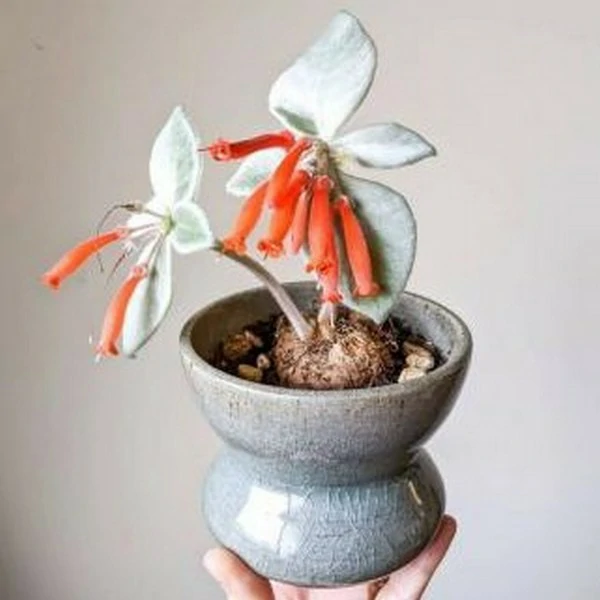
- 温度控制:大岩桐适宜的生长温度为10-25℃,冬季要保持室温在7-10℃之间,夏季温度超过30℃时会进入休眠状态,需放在阴凉处。
1.Temperature control: The suitable growth temperature of the large rock tree is 10-25℃, the room temperature should be kept between 7-10℃ in winter, and the summer temperature will enter a dormant state when the temperature exceeds 30℃, which needs to be placed in a cool place.
2.光照管理:大岩桐喜半阴环境,避免阳光直射,春夏秋冬三个季节需提供足够的散射光,但不能长时间暴晒,否则叶片会菱
2.Light management: Prefer semi-shade environment, avoid direct sunlight. Spring, summer, autumn and winter need to provide enough scattered light, but can not be exposed to the sun for a long time, otherwise the leaves will shrink.
3.浇水方法:大岩桐喜湿润环境,但需避免过度浇水导致根部腐烂。浇水时应观察盆土表面变白或出现裂纹后再浇,保持盆土润而不湿。
3.Watering method: Prefer a humid environment, but avoid excessive watering resulting in root rot. When watering, the soil surface should be observed to turn white or crack before pouring, to keep the soil moist and not wet.
4.施肥技巧:大岩桐喜肥,但需薄肥勤施。生长季节每10天左右施一次氨磷钾复合肥,冬季减少施肥或停止施肥。施肥时避免肥料沾污叶面,施后需水清洁叶面
4.Fertilization skills: Prefer fertilizer, but need thin fertilizer frequently applied. Every 10 days or so in the growing season, apply ammonia, phosphorus and potassium compound fertilizer, and reduce or stop fertilization in winter. Avoid soil contamination when applying fertilizer, and need water to clean the leaf surface after application.
5.修剪与换盆:及时修剪枯叶和残花,保持株型美观。每年春季换盆,选择透气性好的土壤,如泥炭土和珍珠岩混合土。换盆时修剪根部以促进新根生长。
5.Pruning and changing pot: Timely pruning dead leaves and residual flowers to keep the plant shape beautiful. Change the pot every spring and choose a soil with good air permeability, such as peat soil and perlite soil. Prune the roots when changing pots to encourage new root growth.
6.病虫害防治:常见病害有叶枯病和根腐病,需加强通风和降低湿度预防。虫害如蚜虫和红蜘蛛,可用相应杀虫剂防治。
6.Pest control: Common diseases are leaf blight and root rot, need to strengthen ventilation and reduce humidity prevention. Pests such as aphids and red spiders can be controlled with appropriate insecticides.
大岩桐的种植步骤包括: Planting steps include:
- 切割种球:选择经过休眠的2-3年老球茎,秋季或冬季进行催芽,将球茎切成2-4块,每块带有一个芽。
1.Cutting: Select 2-3 old ones that have been dormant, bud in autumn or winter, and cut into 2-4 pieces, each with a bud.
2.种球消毒:将球根晾晒1小时,用多菌灵或高锰酸钾消毒伤口。
2.Disinfection: Dry the root for 1 hour and disinfect the wound with carbendazim or potassium permanganate.
3.盆土选择:使用疏松透气的土壤,如草炭土、石、珍珠岩混合土。
- Soil selection: Use loose and breathable soil, such as turf soil, stone, perlite mixed soil.
4.种植上盆:在盆土中间挖坑,将切面朝下埋入土中,根系部分也埋入,保持温度在15℃以上。
- Planting: Dig a pit in the middle of the basin soil, bury the cut side down in the soil, the root part is also buried, and keep the temperature above 15℃.
鳞芹属/Bulbine spp
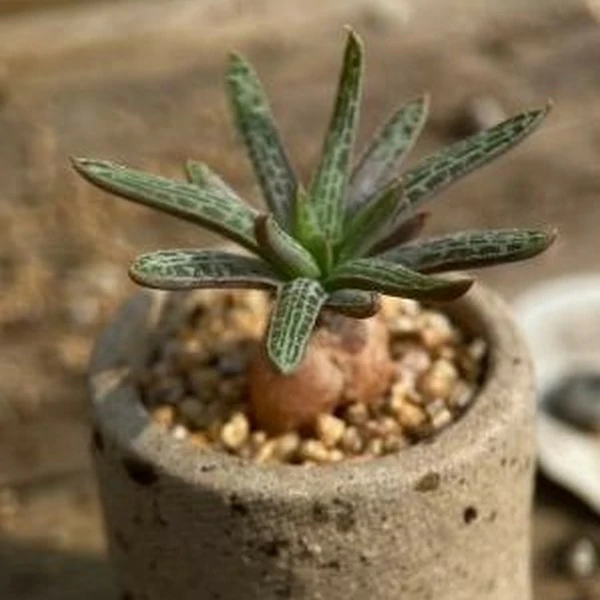
- 生长环境:鳞芹属多肉植物喜欢凉爽、湿润和阳光充足的环境,大部分是冬型种,怕湿热,耐半阴,也耐干旱,有一定的耐寒性。它们在夏季高温时会进入休眠状态,而在秋季至春季的冷凉季节生长。
- Growth environment: Bulbine succulents like cool, humid and sunny environments. Most of them are winter-type species, afraid of heat and humidity, tolerant of semi-shade, drought, and have a certain degree of cold resistance. They will enter a dormant state during the high temperature in summer and grow in the cool season from autumn to spring.
- 土壤和浇水:鳞芹属多肉植物需要疏松而排水良好的土壤。在生长期,可以每月浇水一次,并每月施肥一次。在休眠期,应减少浇水,保持土壤微即可,避免叶片腐烂。
2.Soil and watering: Bulbine succulents need loose and well-drained soil. During the growing season, you can water once a month and fertilize once a month. During the dormant period, you should reduce watering and keep the soil light to avoid leaf rot.
- 温度和湿度:鳞芹属多肉植物适宜的生长温度为5℃至20℃℃,冬季应保持在这个温度范围内。它们不耐高温和湿热,温度超过35℃时容易腐烂。夏季应放在干燥、通风处,避免淋雨。
- Temperature and humidity: The suitable growth temperature for Bulbine succulents is 5℃ to 20℃, and they should be kept in this temperature range in winter. They are not resistant to high temperature and humidity, and are prone to rot when the temperature exceeds 35℃. In summer, they should be placed in a dry and ventilated place to avoid rain.
- 繁殖方法:鳞芹属多肉植物主要通过播种或分株繁殖。播种一般在秋季进行,播后需保持土壤和空气湿润,避免浇水时将种子或小苗冲出土壤。分株繁殖的植物根部会变小,不具备块根。
4.Propagation method: Bulbine succulents are mainly propagated by sowing or division. Sowing is generally done in autumn. After sowing, the soil and air should be kept moist to avoid washing the seeds or seedlings out of the soil during watering. The roots of plants propagated by division will become smaller and will not have tuberous roots.
十二卷属 Haworthia
1.原来有150种左右,产南非和马达加斯加。现在经种间杂交产生很多栽培变种,如玉扇(截形十二卷)和万象(毛汉十二卷)的品种现在都在100种以上。Haworthia, a genus of succulents, originally consisted of about 150 species native to South Africa and Madagascar. Now, through interspecific hybridization, many cultivated varieties have been developed. For instance, varieties of the Haworthia Truncata (Haworthia truncata Schönland ) and Haworthia Maughanii (Maughan’s Haworthia) exceed 100 each.
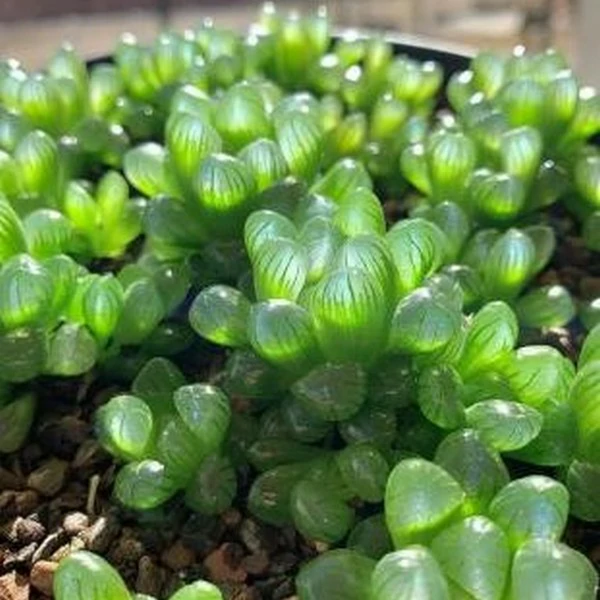
1.土壤选择:十二卷属多肉植物喜欢疏松、透气、排水性好的土壤。可以使用3-5种颗粒(如赤玉土、绿沸石、日向石、火山岩等)和泥炭土按7:3的比例混合,再混入少量碳粒和缓释肥作为培养土。
Soil Selection: Haworthia succulents prefer loose, airy, and well-draining soil. A mix of 3-5 types of particles (such as akadama, green zeolite, hyuga-nishi, volcanic rock, etc.) and peat moss in a 7:3 ratio can be used, with a small amount of carbon granules and slow-release fertilizer added as potting soil.
- 光照:十二卷属多肉植物需要充足的光照,但避免强光直射。置于明亮的生长环境,肉质叶片会更加充实、清晰透明。如果长期置于阴暗环境,植株容易徒长。夏季应置于阴凉通风处或遮阴。
2.Light: Haworthia succulents require ample light but should avoid direct strong sunlight. Placing them in a bright growth environment will make the fleshy leaves more plump and clear. If kept in a dark environment for a long time, the plant may become leggy. During the summer, they should be placed in a cool and ventilated area or shaded.
- 温度:十二卷属植物多为冬型种,适宜的生长温度为18-22℃,冬季需保持在10℃以上。春秋两季是生长旺季,夏季高温时植株处于半休眠状态,需保持盆士稍微干燥。
3.Temperature: Most Haworthia species are winter types with an optimal growth temperature of 18-22°C. In winter, the temperature should be kept above 10°C. Spring and autumn are the peak growth seasons, while the plant enters a semi-dormant state during the high temperatures of summer, requiring slightly drier soil.
4.浇水:生长期可保持盆土微湿润,夏季高温时盆土保持稍微干燥,秋季叶片恢复生长时保持湿润。冬季严格控制浇水,硬质系稍微少浇水,软质系稍微多浇水。
4.Watering: During the growing season, the soil can be kept slightly moist. In the high temperatures of summer, the soil should be kept slightly dry. When the leaves resume growth in autumn, keep the soil moist. In winter, strictly control watering, with less water for hardy types and slightly more for soft types.
5.施肥:生长期可每月施一次腐熟的稀薄液肥或低氨高磷钾的复合肥。夏季高温或冬季低温时的休眠期停止施肥。
- Fertilizing: During the growing season, apply a diluted, well-decomposed liquid fertilizer or a compound fertilizer low in nitrogen and high in phosphorus and potassium once a month. Stop fertilizing during the dormant periods of high summer temperatures or low winter temperatures.
6.换盘:夏季是大多数多肉植物休眠的季节,不适合购买和换盘栽。换盘时可以选择富含腐殖质的草炭土、泥炭土或腐叶土,透气的轻质材料如红砖、河沙、山体风化沙等按3:6.1混合 。
- Repotting: Summer is the dormant season for most succulents and is not suitable for purchasing or repotting. When repotting, choose soil rich in humus such as peat, sphagnum moss, or decomposed leaf soil, and airy lightweight materials like red brick, river sand, or weathered mountain sand mixed in a 3:6:1 ratio.
- 环境:可以闷养,春秋冬用玻璃缸闷养,夏天放室内通风凉爽处。闷养的优势在于湿度大,日夜温差大,这是十二卷属多肉最喜欢的环境。
7.Environment: Haworthia can be grown in a humid environment, with glass jars used for humid cultivation in spring, autumn, and winter, and placed in a well-ventilated and cool indoor area during the summer. The advantage of humid cultivation is the high humidity and large diurnal temperature difference, which is the favorite environment for Haworthia succulents.
琉桑属 Dorstenia
产非洲和美洲的热带地区Dorstenia, cultivated in tropical regions in Africa and America.
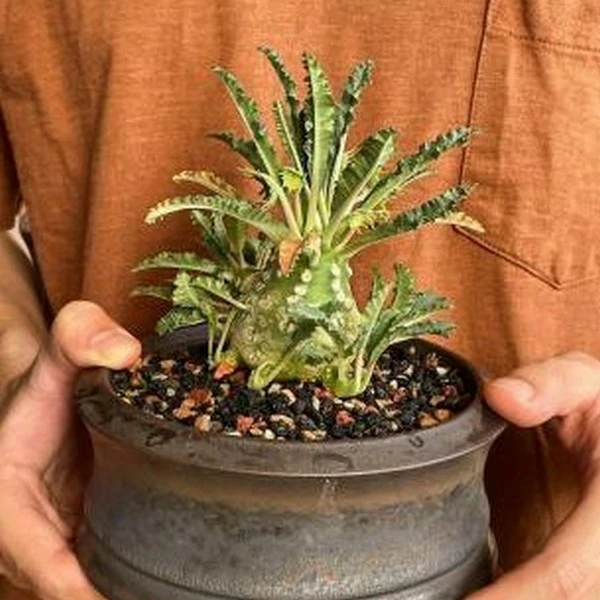
- 浇水:琉桑属多肉植物属于夏型种,温暖季节生长旺盛,夏天吸水能力强,需保持土壤湿润,但避免积水。进入秋天后,植物开始落叶,应减少浇水频率,冬季进入休眠期,需节制浇水,避免“低温高湿”环境。
1.Water: Dorstenia succulents are summer-type plants that grow vigorously in warm seasons ,and have strong water absorption capacity in summer, the soil needs to be kept moist, but avoid waterlogging. After entering autumn, the plants begin to shed their leaves, so the frequency of watering should be reduced. In winter, they enter a dormant period, so watering should be controlled, avoid a “low temperature and high humidity” environment.
2.土壤:宜用沙壤土种植,生长旺盛时可施淡的液肥。配土建议采用疏松透气的土壤,如
泥炭渣、轻石配土或椰糠珍珠岩配土。
2.Soil: Sandy loam is suitable for planting. When the growth is vigorous, light liquid fertilizer can be applied. It is recommended to use loose and breathable soil, such as peat residue,light stone soil or coconut bran perlite soil.
3.日照:琉桑属多肉植物喜光,但夏季需适当遮阴,避免强光直射。室内养护时应放在光线明亮的地方
3.Sunlight: Dorstenia succulents like light, but they need to be properly shaded in summer to avoid direct sunlight. When indoors, they should be placed in a bright place.
4.繁殖:主要通过扦插和种子繁殖。种子繁殖时,需注意种子成熟后会弹射,建议在花盘
上套网袋以收集种子
4.Propagation: Mainly through cuttings and seeds. When propagating seeds, please note that the seeds will eject after they mature. It is recommended to put a net bag on the flower disk to collect the seeds.
5.施肥:生长期每半月施一次缓释肥,花期施少量钾肥 。
5.Fertilization: Apply slow-release fertilizer once every half month during the growing season, and apply a small amount of potassium fertilizer during the flowering period
回欢草属Anacampseros
主要产南部非洲,但阿根廷和澳大利亚各有1种。习性有夏型和冬型之分,一般具有纸质托叶的是冬型,夏天休眠(银蚕)Anacampseros occurs mainly in Southern Africa, with one species each occurring in Argentina and Australia. Habits are divided into summer type and winter type, generally with paper leaves is winter type, summer dormant (Anacampseros albissima).
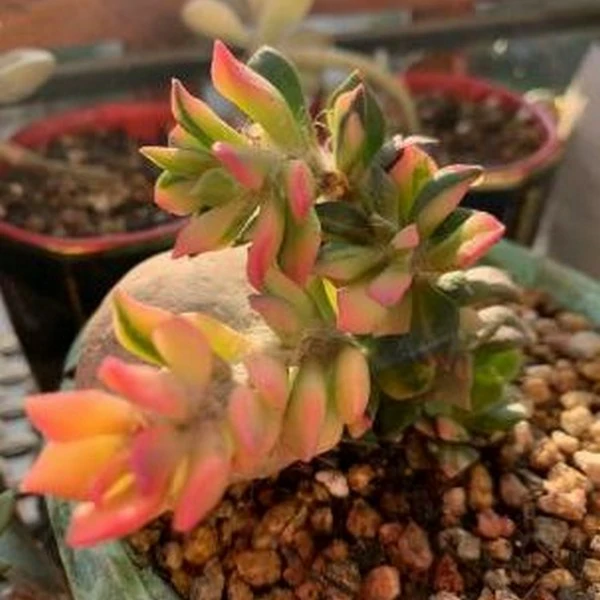
1.盆土要求:回欢草属多肉植物需要疏松透气、排水良好的土壤。建议使用腐殖土或泥炭土与粗砂或蛭石混合,比例为1:3,并可掺入少量骨粉或红玉土等材料,以确保土壤的透气性和排水性。
1.Pot soil requirements: Anacampseros requires loose, breathable, and well-drained soil. It is recommended to use humus soil or peat soil mixed with coarse sand or vermiculite in a ratio of 1:3, and a small amount of bone meal or Akadama soil and other materials can be added to ensure the air permeability and drainage of the soil.
2.光照:回欢草属多肉植物喜欢阳光充足的环境,但在夏季高温时需要适当遮阴,避免持续暴晒。春秋季节可以放在阳光充足的地方,而夏季则应放在明亮无阳光直射处,避免叶片发皱和颜色暗淡。
2.Light: Anacampseros prefers a sunny environment, but they need to be properly shaded during the high temperatures in summer to avoid continuous exposure to the sun. They can be placed in a sunny place in spring and autumn, but should be placed in a bright place without direct sunlight in summer to avoid wrinkling of the leaves and dull color.
3.浇水:浇水要浇透,避免土壤积水导致根部腐烂。春秋季节土干透后再浇透水,夏季少量浇水,保持盘土微潮即可.
3.Watering: Water thoroughly to avoid waterlogging in the soil which may cause root rot. Water thoroughly in spring and autumn when the soil is completely dry. Water lightly in summer to keep the soil slightly moist.
4.施肥:由于回欢草属多肉植物生长缓慢,对养分需求较小,一般不需要额外施肥,让其自然生长即可 。
4.Fertilization: Since Anacampseros grows slowly and have small nutrient requirements, they generally do not require additional fertilizer and can be allowed to grow naturally.
5.通风:夏季要注意通风良好,避免闷热潮湿的环境,以防烂根。冬季在室内养护时也需要保持良好的通风
- Ventilation:Pay attention to good ventilation in summer and avoid hot and humid environment to prevent root rot. Good ventilation is also required when maintaining indoors in winter
香兰属/Haraella
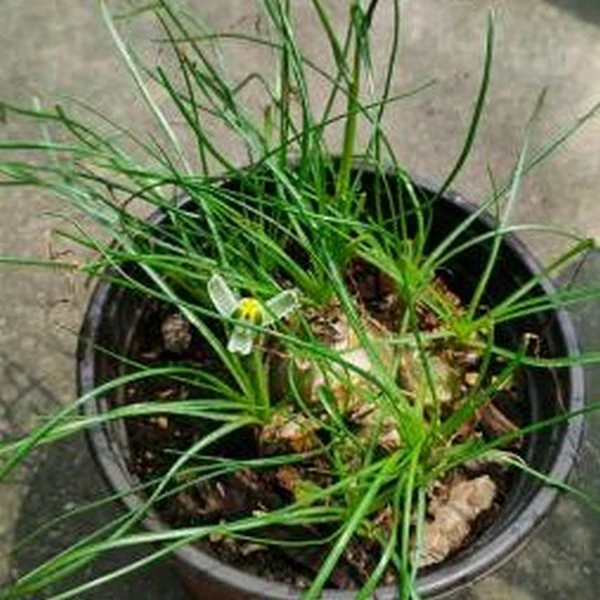
- 光照:喜温暖和半阴环境,忌烈日暴晒,夏季需遮光,遮光率约40-50%,冬季需对其加强光照,有助于开花。
- Light: It likes warm and semi-shady environment, avoids exposure to the sun. It needs shading in summer, with a shading rate of about 40-50%. It needs more light in winter to help it bloom.
2、温度:生长适温为16℃至28℃,在30℃以上时,须加强遮阴通风,否则会出现落叶现象,越冬至少保持10℃以上。
- Temperature: The suitable temperature for growth is 16℃ to 28℃. When it is above 30℃, shade and ventilation must be strengthened, otherwise leaves will fall, and the temperature should be kept at least 10℃ for wintering.
3、浇水:无须表面浇水,保持盆里有水,水位不要超过内部黑色盆。储足水可以供应数周。可经常向叶面及植株周围喷水,增强湿度。
- Watering: No surface watering is required. Keep water in the pot and the water level should not exceed the internal black pot. Sufficient water can be supplied for several weeks. You can often spray water on the leaves and around the plant to increase humidity.
4、花期:多于春季开花,花期20余天。花后应将所有弱枝、顶枝以及过长的下垂枝修剪,有利于新花枝在翌春萌发生长。
- Flowering period: It blooms more in spring, with a flowering period of more than 20 days. After flowering, all weak branches, top branches and overly long drooping branches should be pruned, which is conducive to the sprouting and growth of new flower branches in the following spring. 2. Temperature: The suitable.
风信子属/Hyacinthus
广泛分布于南非和纳米比亚东南部Lithops, Widely distributed in South Africa and southeastern Namibia
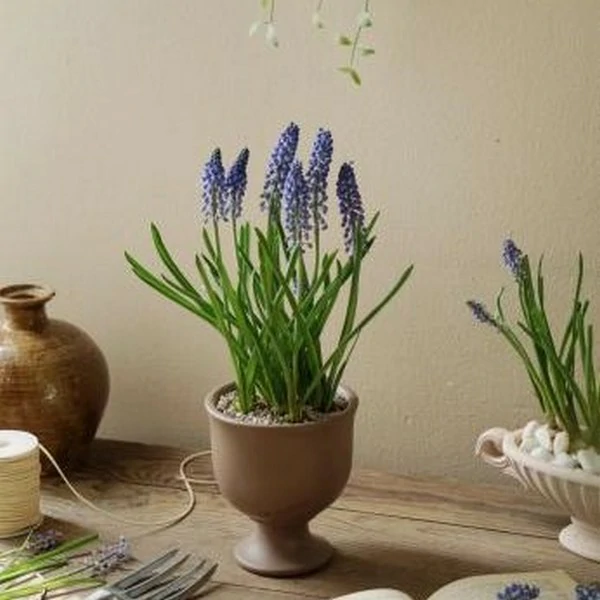
1光照
风信子需要充足的光照,属于长日照植物。在生长过程中,应保证每天接受1-2小时的散射光,避免强光直射。在生长期和开花期,需要更多的光照,但开花后应减少光照,以延长花期 。
1 Illumination
Hyacinths need plenty of light and are long day plants. During the growth process, it should be ensured that 1-2 hours of scattered light is received every day to avoid direct light. During the growing and flowering period, more light is needed, but the light should be reduced after flowering to extend the flowering period.
2水分
风信子喜欢湿润的环境,但不喜欢根部积水。土壤表面干燥时应及时浇水,保持土壤湿润但不要让水直接冲击球根。水培养殖时,需要定期更换水质清洁的水,避免根系腐烂1。
2 Moisture
Hyacinths like wet conditions, but do not like water at the roots. Water when the surface of the soil is dry, keeping the soil moist but not letting the water directly hit the bulb. When aquaculturing, it is necessary to replace clean water regularly to avoid root rot
3温度
风信子的适宜生长温度为15-25摄氏度。在低于10摄氏度或高于25摄氏度的环境中,风信子的生长会受到影响。冬季应注意保温,夏季应注意遮阳
3 Temperature
The optimum growth temperature for hyacinths is 15-25 degrees Celsius. At temperatures below 10 degrees Celsius or above 25 degrees Celsius, hyacinth growth is affected. Winter should pay attention to insulation, summer should pay attention to shade
4土壤
风信子喜欢肥沃、排水良好的沙质壤士。可以选择腐叶土、粗沙和骨粉按比例混合作为种植土壤。水培风信子时,水面应距离种球根盘2-5毫米,避免将种球浸在水中以免腐烂
4 Soil
Hyacinths prefer fertile, well-drained sandy soil. Leaf rot soil, coarse sand and bone meal can be selected as a proportional mix of planting soil. When hydroponics hyacinth, the water surface should be 2-5 mm away from the seed ball root disc, avoid dipping the seed ball in water to avoid rotting
5病虫害防治
风信子在种植前需要进行消毒处理,可以使用多菌灵溶液浸泡种球,然后晾干。这样可以防治霉烂和病菌感染
5 Pest control
Hyacinths need to be disinfected before planting and can be soaked in carbendazim solution and then dried. This will prevent mildew and infection.
盖果漆属/Operculicarya
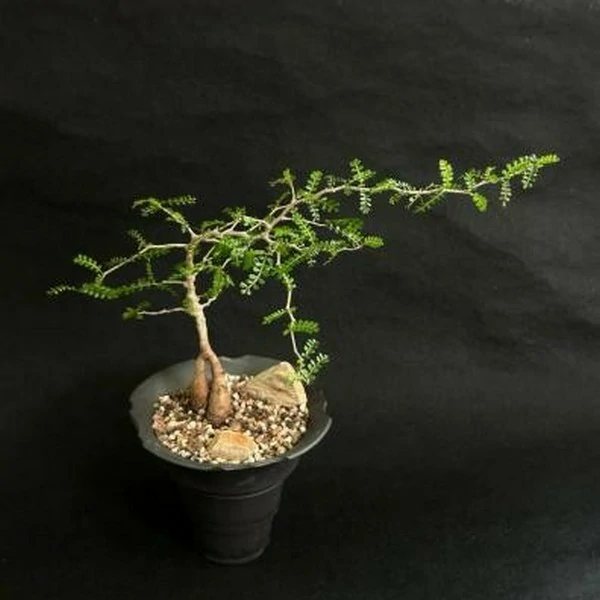
- 光照:盖果漆属植物可以接受全日照养护,明亮散射光也可以正常生长
1.Light: The plant can be maintained in full sun, bright diffuse light can also grow normally
- 水分和肥料:它们喜欢排水性良好的土壤,耐旱,不需要经常浇水。但在生长季节,可以适当多浇水。生长期可适当薄肥勤施。
2.Water and fertilizer: They like well-drained soil, are drought-tolerant, and do not need frequent watering. However, during the growing season, they can be watered more appropriately. During the growing period, thin fertilizers can be applied frequently.
- 温度:盖果漆属植物喜欢温暖环境,不耐寒,低于15度时需要控水,叶片在低温时会落叶休眠,避免浇水
3.Temperature: Operculicarya prefers a warm environment and is not cold-resistant. Watering is required when the temperature is below 15 degrees. The leaves will fall and go dormant at low temperatures. Avoid watering.
虎皮兰/Sansevieria trifasciata
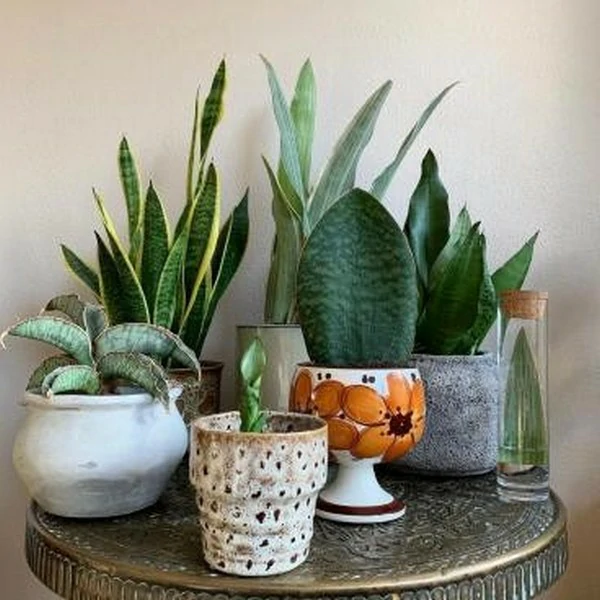
- 光照:虎皮兰喜欢充足的散射光,但要避免强烈的直射阳光。在室内种植时,应将虎皮兰放置在明亮的地方,如靠近窗户的位置。如果光照不足,虎皮兰的叶子会变得黯淡无光,生长速度也会减缓。
- Sunlight: Sansevieriaprefers plenty of diffuse light, but avoids strong direct sunlight. When growing indoors, place the Sansevieria in a bright place, such as near a window. If there is insufficient light, the leaves of the Sansevieria will become dull and the growth rate will slow down.
- 浇水:虎皮兰耐旱,对水分的需求不高。浇水时要遵循“见干见湿”的原则,即土壤表面干燥时再进行浇水。一般情况下,春秋季节每周浇水一次,夏季每5-6天浇水一次,冬季每10-15天浇水一次。浇水过多会导致根部腐烂,影响植株的生长。
- Watering: Sansevieriais drought-tolerant and does not require much water. When watering, follow the principle of “see dry, see wet”, that is, water when the soil surface is dry. Generally, water once a week in spring and autumn, once every 5-6 days in summer, and once every 10-15 days in winter. Excessive watering will cause root rot and affect the growth of the plant.
- 空气湿度:虎皮兰对空气湿度的要求不高,适应力强。但在干燥的冬季,可以适当提高空气湿度,如通过喷水、放置加湿器等方法。
- Air humidity: Sansevieriadoes not require high air humidity and has strong adaptability. However, in the dry winter, the air humidity can be appropriately increased, such as by spraying water or placing a humidifier.
- 施肥:虎皮兰生长旺盛,对肥料需求较大。在生长季节(春季和秋季),每月施一次腐熟的有机肥或者复合肥。冬季温度较低时,可以减少施肥次数。注意不要施用过量,以免烧伤根部。
- Fertilization: : Sansevieriagrows vigorously and requires a lot of fertilizer. In the growing season (spring and autumn), apply well-rotted organic fertilizer or compound fertilizer once a month. When the temperature is lower in winter, the frequency of fertilization can be reduced. Be careful not to apply too much to avoid burning the roots.
- 修剪:虎皮兰生长较快,容易长出过多的侧枝。为了保持植株的美观和健康,需要定期进行修剪。修剪时要注意保留主干和有生长潜力的枝条,剪去病虫害、枯萎和交叉生长的枝条。
- Pruning: Sansevieriagrows fast and tends to grow too many side branches. To maintain the beauty and health of your plants, they need to be pruned regularly. When pruning, pay attention to retaining the main trunk and branches with growth potential, and cut off branches that are diseased, insect-infested, withered, and cross-growing.
- 病虫害防治:虎皮兰容易受到红蜘蛛、蚜虫等害虫的侵扰。一旦发现病虫`害,要及时采取措施进行治疗。可以使用生物防治方法,如放生捕食性天敌,或者使用低毒的农药进行喷洒。
- Pest and disease control: Sansevieriais easily infested by pests such as red spider mites and aphids. Once pests and diseases are found, timely measures should be taken to treat them. Biological control methods can be used, such as releasing predatory natural enemies or spraying with low-toxic pesticides.
- 换盆与繁殖:虎皮兰生长较快,每隔2-3年需要进行一次换盆。换盆时选择透气性好、排水性佳的土壤,如腐叶土、珍珠岩等。虎皮兰的繁殖方法主要有分株和扦插。分株是在春季或秋季将植株分成几份,分别栽种;扦插则是将健康的叶片切成段,插入湿润的沙土中,约1个月后即可生根。
- Repotting and propagation: Sansevieriagrows fast and needs to be repotted every 2-3 years. When repotting, choose soil with good air permeability and drainage, such as leaf mold, perlite, etc. The main propagation methods of Sansevieriaare division and cutting. Division is to divide the plant into several parts in spring or autumn and plant them separately; cutting is to cut healthy leaves into segments and insert them into moist sandy soil. It will take root after about 1 month.
空气凤梨/Tillandsia spp
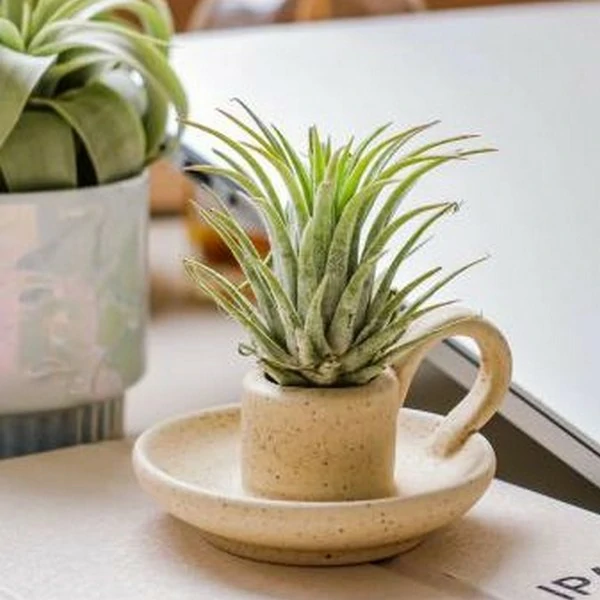
1、光照空气凤梨喜欢明亮的间接光照。将它放在室内明亮的位置,避免直接暴露在强烈的阳光下。如果没有足够的自然光线,可以考虑使用人工光源来提供适量的光照。
1.Light: Air plants enjoy bright, indirect light. Place them in a well-lit area indoors, avoiding direct exposure to harsh sunlight. If natural light is insufficient, consider using artificial light sources to provide adequate illumination.
2、温度和湿度空气凤梨适宜在温暖的环境中生长,理想的温度范围为20-30摄氏度。它也喜欢较高的湿度,可以通过在周围喷洒水雾或将盆放在湿度较高的区域来增加湿度。
2.Temperature and Humidity: Air plants thrive in warm environments with an ideal temperature range of 20-30 degrees Celsius. They also prefer higher humidity levels, which can be achieved by misting the surroundings or placing the pot in a humid area.
3、浇水保持空气凤梨的土壤湿润但不过湿。在下一次浇水前,确保土壤表面已经稍干。避免过度浇水和让盆土积水,这可能会导致根部腐烂。
3.Watering: Keep the soil of air plants moist but not overly wet. Ensure the topsoil is slightly dry before watering again. Avoid overwatering and standing water, which can lead to root rot.
4、排水确保盆底有良好的排水孔,以防止水在盆中积聚。过多的水分可能会导致植物受到病菌和真菌的感染。
4.Drainage: Ensure the pot has good drainage holes at the bottom to prevent water from pooling. Excess watering can make the plant susceptible to bacterial and fungal infections.
5、肥料您可以每月或每两个月给空气凤梨施一次全面肥料。使用适量的室内植物肥料,按照包装上的说明进行施肥。
5.Fertilizer: You can fertilize air plants once a month or every two months with a balanced fertilizer. Use an appropriate amount of indoor plant fertilizer, following the instructions on the packaging.
6、喷水雾喷洒适量的水雾在空气凤梨的叶片上,有助于提高湿度并保持叶面的清洁。这可以模拟植物在自然环境中的生长条件。
6.Mist: Mist the leaves of air plants with water to increase humidity and keep the leaves clean. This can simulate the natural growing conditions of the plant.
7、剪裁根据需要,修剪空气凤梨的叶片和枝条。剪去枯黄、受损或过度拥挤的叶片,以促进植物的健康生长。
7.Pruning: Trim the leaves and stems of air plants as needed. Remove yellowed, damaged, or overly crowded leaves to promote healthy growth.
- 病虫害控制定期检查空气凤梨的叶片和茎干,以发现任何可能的病虫害。如果发现问题,使用合适的杀虫剂或药物进行控制。
8.Pest and Disease Control: Regularly inspect the leaves and stems of air plants for any signs of pests or diseases. If issues are detected, use appropriate insecticides or treatments for control.
施肥和扦插工作不宜继续进行哦!肉肉四季需要阳光,所以冬季也需要尽量放在有光照处养护啦!
(Refers to varieties that grow in summer and hibernate in winter), so when the local temperature is below 5 degrees, you should start to control the water of summer-type succulents, or even cut off the water. If you maintain them in an air-conditioned room and the air is dry, you can spray some water appropriately!
Fertilization and cutting work should not continue! Succulents need sunlight all year round, so they need to be maintained in a lighted place as much as possible in winter!
- 仙人掌科:多数仙人掌科植物都属于夏型种。(仙人掌不能算是也就没有算是了)
1、Cactaceae:Most cactus plants are summer-type species. (If cacti are not considered summer-type, then they are not considered summer-type.)
2、大戟科:多数大戟科植物都属于夏型种。
2、Euphorbiaceae: Most Euphorbiaceae plants are summer type species.
3、伽蓝菜属:常见有唐印,扇雀、玉吊钟、锦蝶、黑兔耳、白兔耳、江户紫,月兔耳, 仙女之舞等。
3.、Kalanchoe: Common ones include Tang Seal, Fan Sparrow, Jade Bell, Brocade Butterfly, Black Rabbit Ears, White Rabbit Ears, Edo Purple, Moon Rabbit Ears, Fairy Dance, etc.
4、青锁龙属:常见有花簪、若绿、神刀、花月、火祭、青锁龙、落日之雁等。(谁让上述几种都很皮实)
4、Crassula : Common ones include Hua Zan, Ruo Lu, Shen Dao, Hua Yue, Huo Ji, Qing Lock Dragon, Sunset Goose, etc. (Who makes the above types very tough)
5、瓦松属:常见 钝叶瓦松、凤凰、富士、子持莲花,岩年华,狼爪瓦松等。(更主要是冬季休眠的关系)
5、Orostachys : Common Sphaerocephala obtuse, Phoenix, Fuji, Lotus, Rock Year, Wolf Claw Sphaerocephala, etc. (mainly related to winter dormancy)
6、龙舌兰属:常见有龙舌兰,雷神、王妃雷神、吹上,王妃世之雪等。
6、Agave: Common ones include Agave, Thor, Princess Thor, Fubuki, Princess Shizhixue, etc.
7、水牛角属:常见有紫龙角,剑龙角,龙角,阿修萝,赤缟牛角等。
7、Caralluma:common ones include purple dragon horn, stegosaurus horn, dragon horn, Asura, red striped ox horn, etc.
8、吊灯花属:常见有爱之蔓,绿雨等。
8、Ceropegia: Common species include love vine, green rain, etc.
9、酒瓶兰属:酒瓶兰。Beaucarnea recurvata: Beaucarnea recurvata.
10、虎尾兰属:虎尾兰。Sansevieria: Sansevieria.
11、芦荟属:木立芦荟、不夜城芦荟等。Aleo: Aloe arborescens, Aloe × nobilis Haw, etc.
12、长生草属:百惠、卷绢等。(完全不觉得是)Sempervivum: Sempervivum calcareum, Oubeni-Makiginu, etc.
13、拟石莲花属:雪莲、黑王子、吉娃莲、黄丽、锦司晃、红司、大和锦、白牡丹等。(拟石莲花属实际基本都是春秋型)Echeveria: Laui, black prince, chihuahuaensis, Adolphii, Setosa, Nodulosa, Purpusiorum, Titubans, etc. (Echeveria species are mostly spring and autumn types)
14、沙漠玫瑰属:沙漠玫瑰、索马里沙漠玫瑰。Adenium obesum: Adenium obesum, Adenium Somalense, etc.
15、棒捶树属:光堂、密花瓶干、惠美须笑、天马空等。 Pachypodium: Namaquanum, Densiflorum, Brevicaule, Succulentum, etc.
16、鸡蛋花属:黄花鸡蛋花。 Plumeria: Yellow Plumeria.
17、亚龙木属:亚龙木、亚森丹斯树。 Alluaudia procera: Alluaudia procera, Alluaudia ascendens.
18、白雀珊瑚属:龙凤木、大银龙、华银龙等 Pedilanthus tithymaloides ssp.smallii: Pedilanthus tithymaloides.
19、白粉藤属:翡翠阁 Cissus: Cissus quadrangularis.
20、回欢草属:吹雪之松、春梦殿锦、花吹雪等 Anacampseros: rufescens, rufescens ‘Sunrise’, tomentosa, etc.
21、马齿苋属:金枝玉叶、雅乐之舞、紫米粒等 Portulaca oleracea: Portulacaria afra, Pailulacaria afra var.foliis-variegatis, Portulaca gilliesii, etc.
22、毛马齿苋属:毛马齿苋、野火、白法师等 Portulaca pilosa: Portulaca pilosa, Wild fire, White Master, etc.
23、国章属:犀角、牛角、大花犀角、妖星角等 Stapelia: Orbea variegata Haw, Stapelia grandiflora Masson, Stapelia flavopurpuream etc.
24、露子花属:雷童、丽晃、妆卵玉 Delosperma: Delosperma echinatum, Delosperma cooperi, etc.
25、棒叶花属:群玉、五十铃玉 Fenestraria: Fenestraria rhopalophylla, Fenestraria aurantiaca N. E. Br.
26、火星人属:京舞妓、圆叶富根草 Fockea edulis: Fockea crispa
27、琉桑属:巨琉桑、针叶琉桑 Dorstenia elata: Dorstenia gigas, Dorstenia gypsophila.
28、厚叶草属:露草等 蓝松、桃美人、星美人、红稚莲均为无明显休眠期植物。
Pachyphytum: Senecio serpens , Pachyphytum ‘Blue Haze’, Pachyphytum oviferum J. A. Purpus, all without obvious dormant period.
Common “winter-type” (i.e. hibernating in summer and growing in winter) succulents. Winter-type succulents are more cold-resistant than summer-type succulents, but it does not mean that they can be grown outdoors at sub-zero temperatures.
- 十二卷属:常见有条纹十二卷,宝草,玉露,寿,玉扇,万象,等。
Haworthia: Common ones include Haworthia fasciata, Haworthia cymbiformis, Haworthia Cooperi, Haworthia retusa, Haworthia truncata, Haworthia maughanii
2、角殿属:常见有大苍角殿。
- Bowiea: Common ones include Bowiea volubilis.
3、鲨(沙)鱼掌属:常见有艾氏沙鱼掌,暗闇牛。
- Gasteria: Common ones include Gasteria ellaphieae, Gasteria exceisa.
4、青锁龙属:小米星,波尼亚
4.Crassula: Common ones include Crassula ‘Tom Thumb’, Crassula Browniana.
5、生石花属:常见有生石花,花纹玉,日轮玉。
- Lithops: Common ones include Lithops, patterned jade, sun wheel jade.
6、肉锥花属:少将。
6.Conophytum: Bilobum.
- 银波锦属:福娘。
7.Cotyledon: Orbiculata.
8、回欢草属
8.Anacampseros
9、肉黄菊属
9.Faucaria
10、照波属:照波。
10.Bergeranthus: Bergeranthus multiceps.
11、菱蛟属:唐扇等。
11.Aloinopsis: Aloinopsis schooneesii, etc.
- 光玉属:光玉。
12.Frithia: Frithia pulchra
13、天女属:天女、天女冠、天女簪。
Titanopsis: Titanopsis calcarea, Titanopsis schwantesii
14、春桃玉属:绫耀玉、南蛮玉。
14.Dinteranthus Schwantes: Dintheranthus vanzylii, Dintheranthus pole-evansii
Common “Spring and Autumn Type” succulents (i.e. intermediate types, growing in spring and autumn) (in winter, when the temperature is lower and the growth vitality of succulents is weak, water control is required. You can refer to the winter maintenance of summer-type succulents!
- 景天属(春秋型种):常见有铭月,乙女心,八千代,虹之玉,圆 叶万年草等。
Sedum (Spring and Autumn type)Common ones include Sedum nussbaumerianum ,Sedum pachyphyllum Rose, Sedum corynephyllum, Sedum x rubrotinctum Clausen , Sedum makinoi ‘ogon’ , etc.
- 莲花掌属(春秋型种):灿烂、爱染锦、明镜、艳日辉、夕映,黑法师等。(以莲花掌属夏季休眠的习惯,被归入冬型种都不奇怪)
Aeonium (Spring and Autumn type):Aeonium decorum ‘Sunburst’ , Aeonium domesticum fa Variegata, Aeonium tabulaeforme, Aeonium decorum f. variegata, Sunset Shadow,Aeonium arboreum ‘Atropurpureum’ , etc. (Given the habit of Aeonium to hibernate in summer, it is not surprising that it is classified as a winter type)
- 仙宝属(春秋型种):小松波、稀宝、紫晃星等。
Cercidiphyllum (Spring and Autumn type): Kosongbo, Trichodiadema stelligerum , Trichodiadema densum Schwantes , etc.
- 舌叶花属(春秋型种):宝绿等。
Glottiphyllum (Spring and Autumn type): Glottiphyllum linguiforme , etc.
- 千里光属:紫蛮刀、佛珠、是春秋型。
Senecio: crassissimus ,rowleyanus , are spring and Autumn type.
- 对叶花属(春秋型种):常见有帝玉,青鸾等。
Pleiospilos (Spring and Autumn type): Common ones include nelii Schwantes , simulans, etc.
- 舌叶花属(春秋型种):常见有安绿,早乙女,新妖等。
- Glottiphyllum (Spring and Autumn type): Common ones include Glottiphyllum longum , Glottiphyllum nelii , and Glottiphyllum peersii, etc.
- 天锦章属(春秋型种):天锦章、神想曲、御所锦等。Adromischus(Spring and Autumn type): Adromischus ,Adromischus poelnitzianus , Adromischus maculatus , etc.
- 银波锦属(春秋型种):熊童子、旭波之光、福娘、银波锦等。
Cotyledon (Spring and Autumn type): tomentosa, Cotyledon.undulata’Hybrid’ , orbiculata, Cotyledon orbiculata var. oblonga , etc.
- 风车草属(春秋型种):美丽莲、胧月。
- Graptopetalum(Spring and Autumn type): bellum,

